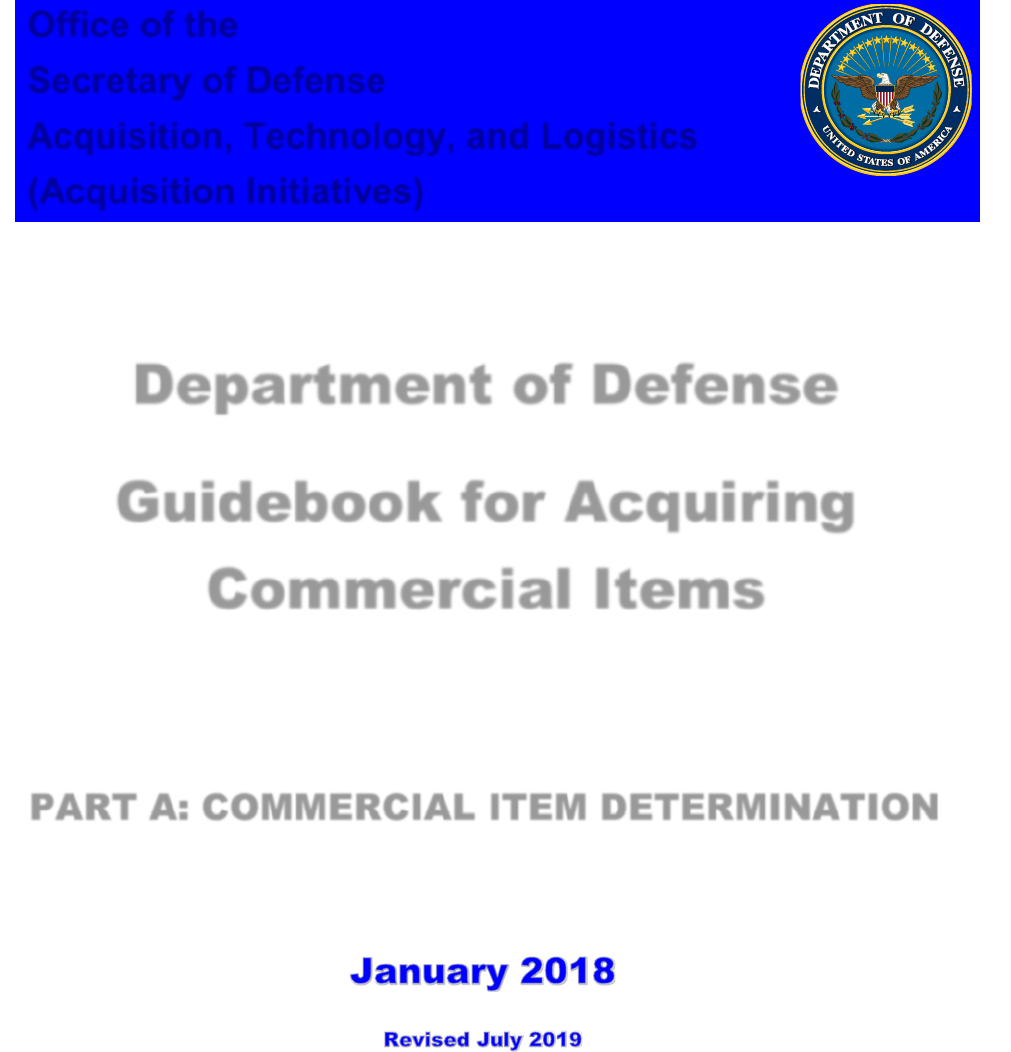
Office of the
Secretary of Defense
Acquisition, Technology, and Logistics
(Acquisition Initiatives)
Department of Defense
Guidebook for Acquiring
Commercial Items
PART A: COMMERCIAL ITEM DETERMINATION

Table of Contents
TABLE OF CONTENTS ..........................................................................................................................2
OVERVIEW .........................................................................................................................................4
VISION FORWARD: SOUND AND TIMELY CIDS ......................................................................................... 4
DEFINITIONS ............................................................................................................................................. 5
MARKET RESEARCH TO ENCOURAGE COMPETITION ............................................................................9
MARKET RESEARCH ACTIVITIES .............................................................................................................. 10
COMMERCIAL ITEM DETERMINATION .............................................................................................. 13
STATUTORY AND REGULATORY OVERVIEW ........................................................................................... 13
USE OF COMMERCIAL ITEM DETERMINATIONS ..................................................................................... 13
THE DCMA CIG AND REQUESTING PRIOR CIDS ................................ ERROR! BOOKMARK NOT DEFINED.
USE OF PRIOR CIDS ........................................................................... ERROR! BOOKMARK NOT DEFINED.
PRIOR CID LOGIC AND CONCLUSION ...................................................................................................... 16
OVERTURNING A PRIOR DOD CID ........................................................................................................... 16
USING A SUBSEQUENTLY-ISSUED DOD CID ............................................................................................ 16
OFFEROR ASSERTIONS OF COMMERCIALITY .......................................................................................... 18
CONTRACTOR DETERMINATIONS OF COMMERCIALITY FOR SUBCONTRACTS ...................................... 18
AGING DOD CIDS .................................................................................................................................... 18
CONVERTING PRIOR FAR PART 12 PROCUREMENT TO A FAR PART 15 NONCOMMERCIAL
PROCUREMENT ...................................................................................................................................... 19
IMPLICATIONS OF FAR PART 12 AND FAR PART 15 PROCEDURES ......................................................... 19
CONTRACTING OFFICER’S RESPONSIBILITY TO SUBMIT CIDS TO DCMA CIG ARCHIVE .......................... 20
INTERPRETING AND USING COMMERCIAL ITEM DEFINITIONS .............................................................. 20
Paragraph (1): Of a Type ................................................................................................................... 21
Paragraph (2): Items Evolved from a Commercial Item (Supply or Service) ...................................... 25
Paragraph (3): Modified Items (Products and Services) of a type ...................................................... 28
Paragraph (4): A Combination of Commercial Items ........................................................................ 33
Paragraph (5): Support Services for an Item (Commercial Product) .................................................. 36
Paragraph (6): Services of a type ....................................................................................................... 43
Paragraph (7): Items Transferred between Divisions of a Contractor ............................................... 48
Paragraph (8): Non developmental Item (Product)............................................................................ 50
OTHER CONSIDERATIONS ................................................................................................................. 52
PRIME CONTRACTOR ASSERTIONS OF SUBCONTRACTOR COMMERCIALITY ......................................... 52
USE OF COMMERCIAL ITEM PROCEDURES FOR NONTRADITIONAL DEFENSE CONTRACTORS .............. 52
MAJOR WEAPONS SYSTEM, SUBCOMPONENTS, AND SPARE PARTS ..................................................... 52
COTS ITEMS ............................................................................................................................................ 52
Obsolescence as it Relates to COTS .................................................................................................... 53
Significance to DoD Procurement ....................................................................................................... 54
SUMMARY HIGHLIGHTS ................................................................................................................... 55
APPENDIX A: INITIAL MARKET RESEARCH RESOURCES ....................................................................... 56
APPENDIX B: TEMPLATE FOR NEW COMMERCIAL ITEMS ................................................................... 59

4
Overview
Commercial item procurement is more important than ever. Although the law has directed a preference for
commercial item procurement since the early 1990s, the time and cost to develop and field new capabilities, the
technological advances made by near peer competitors and the rapid pace of innovation by private industry have
demonstrated the need to access the best technology—now. Commercial research and development (R&D) has
led technological innovation since 1980. DoD needs to increase access to an expanded supplier base—bringing
new and emerging technologies to bear in support of our national defense objectives.
Access to commercial items and practices brings significant benefit to DoD including: creation and integration
of new technology; greater product availability and reliability; reduced acquisition cycle times; lower life cycle
costs; increased competition, and an expanded pool innovative and non-traditional contractors that seek to do
business with DoD. Commercial item procurement is not a panacea, nor does it come without challenges, but it
is a vital tool to achieve our national objectives.
This guide is written for anyone seeking additional understanding on commercial items—the definition, the
determination, and how to price them. This includes supplies purchased from the General Services
Administration Federal Supply Schedule (GSA FSS), which are considered commercial items. Contracting
officers have asked for more examples in the guidebook, and we have complied. All examples are hypothetical
to illustrate a point and bear no relation to any actual experience. A short, simple example is labelled an
“Application.” More complex examples are termed “Practical Examples” and follow a standard format:
Objective; Background; Analysis; Results; and Takeaways. We have added details to make the examples
interesting and thought provoking. The guidebook is designed to be an electronic, searchable resource that DoD
will update as needed, and to which the reader can refer to easily to answer questions.
Many commercial item procurements are relatively simple, assuming that the items or services are readily
identified as commercial, and there is healthy competition in the marketplace. A straightforward commercial
item procurement is usually one of the first tasks assigned to a new contracting specialist. This guidebook,
however, focuses primarily on the difficult issues—those commercial item procurements in which
commerciality may be challenging to discern or those sole source commercial item procurements that are
challenging to determine a fair and reasonable price. Part A of this guide addresses the question, “Is it
commercial?” Part B of this Guide addresses the question, “How do I price this product or service? Part A will
address the strategic and tactical market research necessary to support Federal Acquisition Regulation (FAR)
Part 12 procurement of commercial items. It provides a template recommended for commercial item
determinations (CIDs). Part A discusses procedures to treat previous CIDs, request information from offerors,
and submit CIDs to the DoD Commercial Item Database. The majority of Part A parses each paragraph of the
FAR definition of a commercial item and provides decision trees to help the reader make a CID and to
differentiate among the paragraphs.
VISION FORWARD: SOUND AND TIMELY CIDS
The statutory definition for commercial items is broad, and contracting officers must exercise sound business
judgment in determining whether items or services meet the commercial item definition (see FAR 2.101).
There have been some instances in the past when the Department has taken too much time to assess whether an
item meets the criteria to be deemed a commercial item. Making a determination for of a type items that are
similar to, but not identical to, items that have been sold in the commercial marketplace can be particularly
challenging. Part A of this guide is intended to assist with making timely CIDs.

5
According to 10 U.S.C. 2377, to the maximum extent practicable, requirements must be defined in such a way
that commercial services and supplies could be procured, and that offerors of commercial items and
nondevelopmental items (NDIs) are provided the opportunity to compete in any procurement for such
requirements. FAR Part 12 implements the statutory preference for the acquisition of commercial items. To
implement the requirement, a statement of need must contain sufficient information for potential offerors to
know which commercial products or services may be suitable. To the maximum extent possible, acquisition
officials must state requirements in terms of: (1) functions to be performed; (2) performance required; or (3)
essential physical characteristics. Requirements must be defined in terms that enable and encourage offerors to
supply commercial items, or, to the extent that commercial items suitable to meet the agency’s needs are not
available, supply NDIs, in response to agency solicitations. Not only is this a statutory and regulatory
requirement, but gaining access to commercial items is both a sound business strategy and a national security
imperative.
Things to Consider
• Initial market research is conducted to identify commercial products, services, or
technologies, which can be applied toward deploying and sustaining warfighting
capabilities.
• Are there sufficient sources of commercial or NDIs?
• Who within DoD buys it “the most”? Who has bought it? How have they bought it?
• Can the market sustain the planned or deployed capability over the longer term?
• Is the technology rapidly changing, such that the Government may have to change its
requirements over time to keep up with the marketplace?
• Do manufacturers routinely modify items to meet customer needs? If not, can the item be
modified without involving a development effort?
• Can the requirement be modified, within reason, to accommodate the use of commercial
items or NDIs and still meet your mission needs?
DEFINITIONS
The following definitions are based in statute and provided in FAR 2.101 or DFARS 212.101. The definitions
are provided for convenience as these terms will be used throughout Part A of this Guide.
Commercial Item
“Commercial item” means—
(1) Any item, other than real property, that is of a type customarily used by the general public or by non-
governmental entities for purposes other than Governmental purposes, and—
(i) Has been sold, leased, or licensed to the general public; or,
(ii) Has been offered for sale, lease, or license to the general public;
6
(2) Any item that evolved from an item described in paragraph (1) of this definition through advances in
technology or performance and that is not yet available in the commercial marketplace, but will be available in
the commercial marketplace in time to satisfy the delivery requirements under a Government solicitation;
(3) Any item that would satisfy a criterion expressed in paragraphs (1) or (2) of this definition, but for—
(i) Modifications of a type customarily available in the commercial marketplace; or
(ii) Minor modifications of a type not customarily available in the commercial marketplace made to
meet Federal Government requirements. Minor modifications mean modifications that do not significantly alter
the nongovernmental function or essential physical characteristics of an item or component, or change the
purpose of a process. Factors to be considered in determining whether a modification is minor include the value
and size of the modification and the comparative value and size of the final product. Dollar values and
percentages may be used as guideposts, but are not conclusive evidence that a modification is minor;
(4) Any combination of items meeting the requirements of paragraphs (1), (2), (3), or (5) of this definition
that are of a type customarily combined and sold in combination to the general public;
(5) Installation services, maintenance services, repair services, training services, and other services if—
(i) Such services are procured for support of an item referred to in paragraph (1), (2), (3), or (4) of this
definition, regardless of whether such services are provided by the same source or at the same time as the item;
and
(ii) The source of such services provides similar services contemporaneously to the general public under
terms and conditions similar to those offered to the Federal Government;
(6) Services of a type offered and sold competitively in substantial quantities in the commercial marketplace
based on established catalog or market prices for specific tasks performed or specific outcomes to be achieved
and under standard commercial terms and conditions. For purposes of these services—
(i) “Catalog price” means a price included in a catalog, price list, schedule, or other form that is
regularly maintained by the manufacturer or vendor, is either published or otherwise available for inspection by
customers, and states prices at which sales are currently, or were last, made to a significant number of buyers
constituting the general public; and
(ii) “Market prices” means current prices that are established in the course of ordinary trade between
buyers and sellers free to bargain and that can be substantiated through competition or from sources
independent of the offerors.
(7) Any item, combination of items, or service referred to in paragraphs (1) through (6) of this definition,
notwithstanding the fact that the item, combination of items, or service is transferred between or among separate
divisions, subsidiaries, or affiliates of a contractor; or
(8) A nondevelopmental item, if the procuring agency determines the item was developed exclusively at
private expense and sold in substantial quantities, on a competitive basis, to multiple State and local
governments.
Commercially Available Off-the-Shelf Item
7
“Commercially available off-the-shelf (COTS) item”—
(1) Means any item of supply (including construction material) that is—
(i) A commercial item;
(ii) Sold in substantial quantities in the commercial marketplace; and (iii) offered to the Government,
under a contract or subcontract at any tier, without modification, in the same form in which it is sold in the
commercial marketplace.
(2) Does not include bulk cargo, as defined in 46 U.S.C. 40102(4), such as agricultural products and
petroleum products.
Market Research
“Market research,” means collecting and analyzing information about capabilities within the market to
satisfy agency needs.
As used in DFARS Part 212, “market research” means a review of existing systems, subsystems,
capabilities, and technologies that are available or could be made available to meet the needs of DoD in whole
or in part. The review shall include, at a minimum, contacting knowledgeable individuals in Government and
industry regarding existing market capabilities and pricing information, and may include any of the techniques
for conducting market research provided in section 10.002(b)(2) of the FAR (section 855 of the National
Defense Authorization Act for Fiscal Year 2016 (Pub. L. 114-92)).
Nondevelopmental Item
“Nondevelopmental item” (NDI) means—
(1) Any previously developed item of supply used exclusively for governmental purposes by a Federal
agency, a State or local government, or a foreign government with which the United States has a mutual defense
cooperation agreement;
(2) Any item described in paragraph (1) of this definition that requires only minor modification or
modifications of a type customarily available in the commercial marketplace in order to meet the requirements
of the procuring department or agency; or
(3) Any item of supply being produced that does not meet the requirements of paragraphs (1) or (2) solely
because the item is not yet in use.
Nontraditional defense contractor
“Nontraditional defense contractor” means an entity that is not currently performing and has not performed
any contract or subcontract for DoD that is subject to full coverage under the cost accounting standards
prescribed pursuant to 41 U.S.C. 1502 and the regulations implementing such section, for at least the 1-year
period preceding the solicitation of sources by DoD for the procurement(10 U.S.C. 2302(9)).
8

9
Market Research to Encourage Competition
The ability to acquire affordable products and services significantly improves when there is an in-depth
knowledge of the market and market trends. Market research should occur multiple times during an acquisition
and should not be confined either to initial market research or to market research to determine price
reasonableness. Failing to refresh the results of market research may result in a lack of information and market
insight that will prevent the Government from optimizing the acquisition. The quality of the market research
affects the quality of competition, and a DoD component should ensure sufficient resources are available to
conduct market research.
The purpose of presolicitation market research is to determine what is available, if it would suit your purpose, if
the acquisition strategy could be adjusted to use a commercial item, or if the commercial item would need to be
modified slightly to fit your needs. Your presolicitation market research may lead you to conclude that
adequate commercial items are not available, and you may recommend developing new items, but that likely
will increase both the time and expense to obtain and sustain the item.
Specifically, presolicitation market research answers the following questions:
The review may include any of the techniques for conducting market research provided in FAR 10.002(b)(2)
and should, at a minimum, include contacting knowledgeable individuals in Government and industry regarding
existing market capabilities and the prices at which those capabilities or technologies have been offered for sale
or sold, and other practices common to that industry. It also includes a review and identification of how the
desired capabilities or technologies are generally offered for sale in the marketplace in question and other
contract terms that may affect differences in pricing, such as warranties, buyer financing, volume (or other)
discounts, as well as the customary practices in the industry regarding customizing, modifying or tailoring of
items or services to meet a customer’s needs and budget. It is useful to gather this information early as it will
be beneficial throughout the acquisition process.
Market research has always been the solid foundation for commercial acquisition, but has become increasingly
important, since it will serve as the basis for not only your CID, but also future CIDs made by fellow DoD
contracting officers. Common terms and conditions used in commercial contracts that are characteristic of
certain industries will affect your decision making and needs to be documented to capture your thought process
for the CID. In addition, those commercial terms and conditions may also affect the commercial item pricing
discussed in Part B of this Guide.
Pursue Other Than
Commercial Item Procurement
NO
NO
YES
YES
Can the
requirements
be modified?
Are
commercial
items
available?
YES
Pursue Commercial Item
Procurement IAW FAR Part 12
Can
commercial
items be
reasonably
modified?

10
Things to Consider
As FAR Part 10 points out, some of the market research issues that you may wish to consider
during your presolicitation market research include the following:
• Identification of the industry and market for the capabilities or technologies.
• The prices at which those capabilities or technologies have been offered for sale or
sold.
MARKET RESEARCH ACTIVITIES
A summary of typical market research steps and best practices are provides as follows:
Preparation:
Identify and understand the key characteristics of the requirement.
Assemble a team of individuals familiar with the marketplace, requirement, contracts, etc.
and establish communications.
Identify the market research objectives.
Develop the market research strategy (team assignments, information needs, information
gathering sources and techniques, etc.).
Begin investigating the market. Evaluate whether commercial items or services are available
documenting the results along the way.
Best practices:
Start early while the requirement is still flexible.
Reach out to other users of commercial items and the services (including providers of the
services).
Communicate with your team.
Involve users in the process.
Use market research to first determine the availability of commercial capabilities, practices,
items, and services to meet the general requirement. Use market research to obtain specific
and detailed information to make various acquisition decisions.
Tailor the market research efforts. Do not waste valuable time. Refine as you proceed, from
general to specific.
Analyze the data received to determine if the market research objectives have been met.
Evaluate if a commercial solution is feasible.

11
Perform trade-off analyses to see if the requirement can be modified to better suit
commercial business practices, terms and conditions.
Documentation. Results should be clearly documented so that the information can be used to
refine the requirement, develop the acquisition plan, solicitation, terms and conditions, work
statement, and evaluation criteria for source selection.
Documentation also provides a historical record of market research efforts, and that market
research was performed.
Market Research Sources and Techniques:
Ask your counterparts in other DoD components.
Read trade journals.
Contact knowledgeable people (Government and industry) in specific markets.
Contact contracting officers, contract specialists, and project officers in other federal
agencies and private industry (other users). Take advantage of the lessons that these
individuals have learned in previous acquisitions.
Contact known sources of commercial items and services.
Review market surveys prepared by companies and do market surveys to obtain information
from potential sources.
Conduct site visits.
Attend trade shows, conferences, and symposia.
Query Government databases that provide relevant information on acquisitions (see
Appendix A of this Guide).
Use Internet tools search external resources for information on products, sources, market
trends, and pricing (see Appendix A of this Guide).
Review results of recent market research on similar or identical requirements.
Post formal requests for information, sources sought synopses, draft work statements and
solicitations in FedBizOpps, and in appropriate technical or scientific journals and business
publications.
Obtain source lists of similar commercial items and services from other contracting activities
or agencies, trade associations, or other sources.
Review catalogs and literature published by service providers.
Review Federal Supply Schedule contracts and other Government-wide acquisition
contracts.
Conduct interchange meetings or hold presolicitation conferences to involve potential
offerors early in the acquisition process.
Find established structures within the industry where buyers and sellers find each other.

12
Additional guidance for completing market research can be found in the
https://www.acq.osd.mil/dpap/cpic/cp/docs/2017_Market_Research_Guide_(Final).pdf.
Documentation of Market Research
The market research report is the document prepared after all market research information has been compiled.
It summarizes the market research team's activities and provides support for their recommendations. It can help
build the business case for how the contracting officer approaches requirements, supports an Acquisition
Strategy, and supports a CID. It is easier to compile all the information gathered during market research into
one document that will be included in the contract file. Contracting officers should ensure that contract files
fully and adequately document the market research and the rationale supporting a conclusion that the
commercial item definition in FAR 2.101 has been satisfied. Particular care must be taken to document
determinations involving modifications “of a type customarily available in the marketplace,” and items only
“offered for sale, lease, or license to the general public,” but not yet actually sold, leased, or licensed. In these
situations, the documentation must clearly detail the particulars of the modifications and sales offers.
Market Research Key Concepts
Your effort in conducting market research contributes to your market intelligence, identifies potential
solutions, and may enhance competition.
Conduct market research appropriate to each part of the procurement process.
Documentation is an essential part of the market research process. FAR Part 10 requires that market
research results be documented in a manner appropriate to both the size and complexity of the
acquisition.

13
Commercial Item Determination
STATUTORY AND REGULATORY OVERVIEW
41 U.S.C. 3307, Preference for Commercial Items, paragraph (b) states that, to the maximum extent practicable,
the head of each executive agency shall ensure that the requirements of the executive agency (with respect to a
procurement of supplies or services) are stated in terms of functions to be performed, performance required, or
essential physical characteristics.
This preference is implemented in the FAR at Part 12, Acquisition of Commercial Items. FAR 12.101, Policy,
requires agencies to:
• Conduct market research to determine whether commercial items or NDIs are available that could meet
the agency’s requirements;
• Acquire commercial items or NDIs when they are available to meet the needs of the agency; and
• Require prime contractors and subcontractors at all tiers to incorporate, to the maximum extent
practicable, commercial items or NDIs as components of items supplied to the agency.
DoD specific requirements for the acquisition of commercial items are provided in DFARS Part 212. Most
notable is the long-standing requirement for DoD contracting officers to determination in writing that an
acquisition exceeding $1 million in value meets the commercial item definition in FAR 2.101 and to include the
written determination in the contract file.
Recent legislation strengthened the preference for commercial supplies and services for the Department. This
legislation was implemented into the DFARS in 2018 and the following sections provide guidance on some of
those changes.
USE OF COMMERCIAL ITEM DETERMINATIONS
The following sections will address the issues listed below in the following order:
• The DCMA Commercial Item Group (CIG) role as an expert resource to assist in this area and in
maintaining the Commercial Item Database;
• The role of offerors and contractors in providing information on prior commercial item determinations
made by the Department or by the contractor in review of its subcontracts; and
• Assessing prior Commercial Item Determinations (CIDs) and the process for overturning a prior CID;
• The requirements for converting a prior FAR Part 12 commercial procurement to a noncommercial
procurement under FAR Part 15.
• Contracting Officer’s Responsibility to Submit CIDs to DoD Commercial Item Database

14
THE DCMA COMMERCIAL ITEM GROUP (CIG) ROLE AS AN EXPERT
RESOURCE
Section 831 of the NDAA for FY 2013 required the Department to provide “a cadre of experts” to assist
DoD contracting officers in making difficult CIDs. To assist in both the timeliness and consistency of
commercial item determinations, DCMA has established the CIG, comprised of several centers that are
aligned to various contractor market sectors. The centers are staffed with a cadre of engineers and price/cost
analysts to advise contracting officers relating to determinations of commerciality and price reasonableness.
The centers are also staffed with contracting officers that have been authorized by USD(Acquisition &
Sustainment) to make commercial item determinations upon the request of a contracting officer.
.
The CIG supports DoD activities in making informed CIDs using market research and engineering support.
The CIG also assists by evaluating the proposed prices to similar items/services that exist in the commercial
marketplace. The CIG is responsible for maintaining the Commercial Item Database for CIDs made by
contracting officers from across the Department. Please send any recommendations or commercial item
determinations to commercial@dcma.mil.
The DCMA CIG also is a place to get help from a commercial expert with specialized knowledge of
many relevant market sectors. Send your written questions to commercial@dcma.mil, and DCMA
can help answer your questions regarding commerciality and price analysis. For more in-depth
assistance, please submit a completed Commercial Item Customer Request Form (found on the
website at www.dcma.mil/commercial-item-group/) to commercial@dcma.mil.
Application
A recent real world example illustrates DCMA CIG’s assistance to a contracting officer:
A customer reached out to the DCMA CIG asking about a part number. Within minutes, the
CIG produced information showing that the Navy had previously made a commercial
determination on that part number. The CIG provided the contracting officer’s name to the
requestor to confirm the Navy’s CID, and above and beyond the request, the CIG was able
to provide pricing assistance to support a $10K savings per part, based on existing contracts.
The DCMA CIG database enables the Department to share information that eliminates
redundant effort, increases its use of commercial item procurement and expedites
commercial item determinations.
NOTE:
The contracting officer remains responsible and accountable for
making the CID unless he or she chooses to request that DCMA CIG make a
CID, but the contracting officer must abide by the DCMA CIG’s commercial
item determination if requested. The contracting officer may cancel the request
at any time before DCMA issues the CID.

15
THE ROLE OF OFFERORS AND CONTRACTORS IN PROVIDING INFORMATION
ON PRIOR COMMERCIAL ITEM DETERMINATIONS
NOTE: DFARS 212.102(a)(ii)(A) states, “The contracting officer may presume that a prior
commercial item determination, or a determination that overturned a prior commercial item
determination, made by a military department, a defense agency, or another component of DoD shall
serve as a determination for subsequent procurements of such item.”
In other words, a contracting officer may rely on the most recent prior DoD contracting officer’s determinations
for future purchases of the same item, including those CIDs that overturned previous CIDS. If a contracting
officer determines to overturn a prior CID, that contracting officer must request a review by the Head of the
Contracting Activity (HCA) either confirming the prior determination was appropriate and still valid or issue a
revised CID that the prior use of FAR Part 12 procedures was improper or that it is no longer appropriate to
acquire the item using FAR Part 12 procedures, with supporting rationale. When procuring an item that is
similar to (or of a type) an item that was previously determined by a DoD contracting officer to be commercial,
the contracting officer should of course consider the appropriateness of the prior CID. Contracting officers will
consider as reasonable any DoD contracting officer CIDs when preparing a recommendation of commerciality,
unless considerations such as those listed below indicate further analysis of the CIDs is warranted:
Questions to Consider
• Is the prior CID for the same or similar item that you are considering?
• Have you verified that the prior CID is complete and prepared by a DoD component
(unless obtained directly from the activity or an authorized database)?
• Have you analyzed the prior CID to confirm the logic and thoroughness of the
thought process and that it supports the conclusion?
• Did the previous CID identify the paragraph of the FAR definition that applies to this
particular item?
• Did the previous CID properly support the appropriate paragraph of the commercial
item definition of the FAR?
• Did the previous CID state that the commercial item was sold or offered for sale to the
general public or provide supporting documentation to that effect?
• Did you receive information regarding prices paid with the DoD contracting officer’s
prior CID? Remember, even if you accept the prior CID, you still need to determine
what a fair and reasonable price would be for your particular buy. (Covered in Part B).
16
ASSESSING PRIOR COMMERCIAL ITEM DETERMINATIONS (CIDS) AND THE
PROCESS FOR OVERTURNING A PRIOR
CID
P
RIOR CID LOGIC AND CONCLUSION
Although the law states that contracting officers may accept prior CIDs “made by a military department, a
defense agency, or another component of DoD,” the contracting officer should review the content of the CID.
On occasion, a contracting officer may agree with the conclusion that an item is commercial, but believe that
the logic, facts, or documentation supporting that conclusion needs to be improved. A contracting officer may
wish to provide another CID in lieu of the prior CID or to amplify or supplement the original CID.
Contracting officers are not required to seek approval from the HCA for improved or amplified CIDs that do not
overturn the original conclusion. However, contracting officers shall provide a copy of their CID and the
original CID to the DCMA CIG website to archive for the use of and benefit to other DoD contracting officers.
OVERTURNING A PRIOR DOD CID
If the contracting officer believes it is necessary to deviate from a prior DoD determination that an item is
commercial, the contracting officer must document the rationale for a different determination and request a
review by the HCA. To assist in this process, he or she should engage both his or her chain of command and
the DCMA CIG, which has expertise to assist in reviewing the prior determination, and other relevant
information related to determining the commerciality of an item. Contracting officers should use sound
business judgment to determine if the CIG’s opinion would be beneficial in helping to substantiate the
contracting officer’s request to overturn a prior CID. If the prior CID lacks supporting documentation, the CIG
is also a resource that can provide assistance.
If the contracting officer believes it is appropriate to proceed with a procurement of an item that was previously
determined to be commercial using other than commercial procedures, the contracting officer shall request
review by the HCA. Sufficient information should be presented to the HCA to enable a timely review and final
approval or disapproval of a request to overturn a prior CID. Within 30 days, the HCA shall either:
(1) Confirm that the prior determination was appropriate and still applicable; or
(2) Issue a determination that the prior use of FAR Part 12 procedures was improper or that it is no
longer appropriate to acquire the item using FAR Part 12 procedures, with a written explanation of the basis for
revision.
USING A SUBSEQUENTLY-ISSUED DOD CID
Once a contracting officer has improved or amplified a prior CID or prepared a new CID, and it has been
approved by the HCA, then the new or revised CID shall be provided to the DCMA CIG. DoD contracting
officers may rely on the most recent, prior DoD contracting officer’s determinations for any future purchases of
the same item without additional justification. The decision tree that follows illustrates the process for
evaluating a prior CID and engaging the
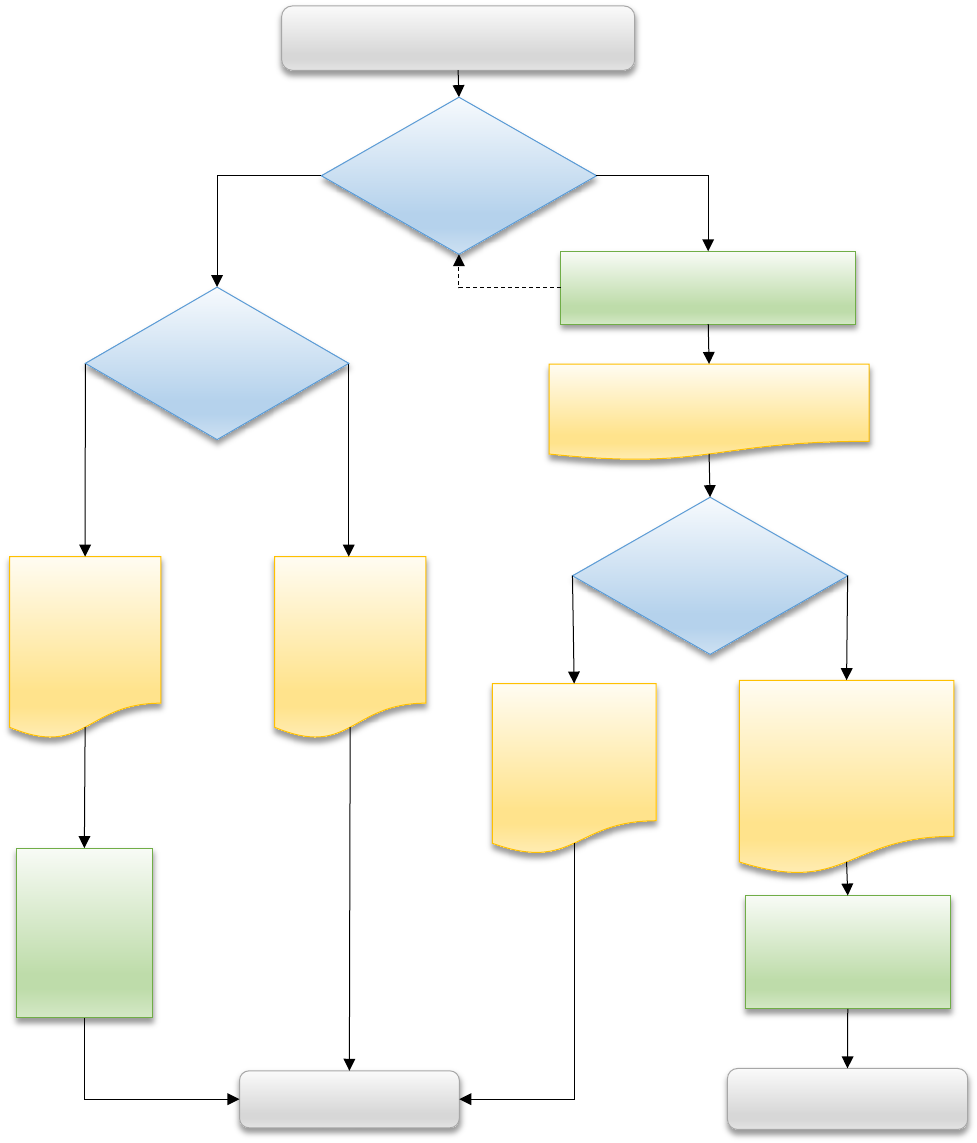
17
*IN ACCORDANCE WITH THE OUSD(A&S) APPROVAL, DATED OCTOBER 2018, DCMA CIG CONTRACTING OFFICERS MAY SERVE AS
DETERMINING OFFICIALS FOR COMMERCIAL ITEMS
.
NO
YES
NO
YES
NO
YES
Contracting Officer (KO)* evaluates
prior CID logic and conclusion
KO documents rationale to overturn
a prior CID in a written determination
and submits for HCA review
Does the HCA
agree with KO
determination?
HCA issues written
determination that use
of Part 12 procedures
was improper or is no
longer appropriate; KO
documents contract file
KO provides the prior
CID and the written
determination to the
DCMA CIG Group
KO documents
the contract file
with amplified
or improved
CID or provide
a new CID
Proceed with
other than FAR Part 12
HCA confirms
prior CID was
appropriate and
applicable; KO
documents
contract file
KO documents
the contract file
regarding
reliance on
prior CID
Proceed with
FAR Part 12
Engage chain of command and
consult with DCMA CIG Group
Does the KO
agree with prior
CID conclusion?
Does the KO
agree with prior
CID logic?
KO provides
the prior CID
and the new
or revised
CID to the
DCMA CIG
Group

18
OFFEROR ASSERTIONS OF COMMERCIALITY
Contractors may assert that their item or service has been determined to be commercial by a military
department, a defense agency, or another component of DoD. In such cases, DFARS provision 252.215-7010,
requires the offeror to provide the associated contract number and the DoD component that awarded the
contract. If available, offerors are encouraged to provide a Government point of contact for those items that
have been previously determined to be commercial. The contracting officer may contact DCMA CIG or the
DoD component to verify the offeror’s assertion and obtain an authentic copy of the original CID made by the
determining organization.
CONTRACTOR DETERMINATIONS OF COMMERCIALITY FOR SUBCONTRACTS
Up to this point, this guide has addressed CIDs, usually for end items, made by a DoD contracting officer;
however, complex noncommercial systems may contain many commercial parts. It is the contractor's
responsibility to make decisions about whether subcontracts meet the definition of commercial items.
Contractors are expected to exercise reasonable business judgment in making such determinations.
Note, in accordance with DFARS clause 252.244-7001, Contractor Purchasing System Administration,
contractors are required to establish and maintain an acceptable purchasing system, which includes, in part, a
requirement to document negotiations in accordance with FAR 15.406-3. Contractors are required to document
the principle elements of the negotiated agreement, to include any exceptions to obtaining certified cost and
pricing data (such as the commercial item exception) and the basis for it. When it is determined that a
contractor purchasing systems review is required (FAR Subpart 44.3), that review will pay special attention to
the results of market research accomplished, to include the adequacy of rationale documenting the contractor's
commercial item determinations (see DFARS 244.303(a)).
These types of reviews may be a valuable source of information for contracting officers making commercial
item determinations on a future prime contract. However, contracting officers may not rely solely on a
contractor's decision about the commerciality of their subcontracts for commercial item determinations for
prime contracts to be awarded by DoD.
AGING DOD CIDS
As noted previously, DFARS 212.102(a)(ii)(A) provides that “the contracting officer may presume that a prior
commercial item determination made by a military department, a defense agency, or another component of the
Department of Defense shall serve as a determination for subsequent procurements of such item.” However, in
some instances, an item that was once clearly commercial with adequate supply and demand in the commercial
marketplace may no longer be sold in the commercial market and may now only be used in military
applications.
NOTE: In general, the Department ascribes to the school of thought that once an item has actually
been bought and sold in the commercial marketplace, it remains commercial. In other words, the fact
an item that was once sold in the commercial marketplace, but now is only sold to DoD, does not
change its commerciality. However, the time since it was last sold in a commercial contract goes to analysis of
price addressed in Part B of this Guide.
19
CONVERTING PRIOR FAR PART 12 PROCUREMENT TO A FAR PART 15
NONCOMMERCIAL PROCUREMENT
The statute (section 856 of Pub. L. 114-92) not only provides that contracting officers may presume that a prior
CID made by another DoD contracting officer shall serve as a determination for subsequent procurements of
that item, but also imposes limitations on converting the procurement of commercial items or services valued at
$1 million or more from a commercial acquisition under FAR Part 12 to a noncommercial acquisition using
FAR Part 15 procedures. This legislation was implemented in DFARS Subpart 212.70, Limitation on
conversion of procurement from commercial acquisition procedures.
Prior to making such a conversion in the method of subsequently acquiring such items, there must be a written
determination establishing that the earlier use of FAR Part 12 was “in error or based on inadequate information”
AND that the Department “will realize a cost savings” using FAR Part 15 as compared to the cost to the
Government (price) of procuring a similar quantity or level of the item or service using FAR Part 12. DFARS
212.7001 contains the procedures that implement this limitation, including the specific factors that must be
addressed in and the approval authority for such written determinations.
IMPLICATIONS OF FAR PART 12 AND FAR PART 15 PROCEDURES
The implications of making a CID and, as a result, employing FAR Part 12 commercial procedures, are
significant, including reducing the number of FAR requirements that will apply to the contract and relying
almost exclusively on price analysis to determine a fair and reasonable price. That follows from the policy that
where items and services are bought and sold in the commercial marketplace, we maximize use of standard
commercial terms and conditions and will pay the going market price (see more in Part B of this Guide).
Further, the commercial exception in 10 U.S.C. 2306a, Cost or Pricing Data: Truth in Negotiations, prohibits
contracting officers from requiring certified cost or pricing data from contractors and subcontractors when
buying commercial items.
The choice between a FAR Part 12 commercial contract and a FAR Part 15 noncommercial contract affects the
Government’s ability to impose terms and conditions in a contract. Unless a particular industry usually expects
customization, the buyer accepts the terms and conditions that are set by the seller and usually reflect common
industry practices. Terms and conditions that accompany a FAR Part 12 contract establish a different business
relationship between the Government (or higher tier contractor) and the supplier. That is by design in law and
policy to entice commercial companies to sell their products and services to the Government by imposing less
restrictive terms than would be imposed upon them for non-commercial products and services. The policy and
statutory limitations on converting prior a FAR Part 12 contract to a FAR Part 15 contract recognizes this
distinction. Once a CID is rendered, contracting officers shall use streamlined FAR Part 12 procedures to the
maximum extent possible.

20
CONTRACTING OFFICER’S RESPONSIBILITY TO SUBMIT CIDS TO DOD
COMMERCIAL ITEM DATABASE.
Finally, the CID is not complete until the contracting officer submits the CID with a summary of pricing
information to the DCMA CIG. The DCMA CIG also welcomes other agencies, or other DCMA offices to
provide recommendations for commerciality they have made. These should be in a written format, with
supporting rationale, in a PDF.
Please send CIDs and CIRs to dcma.boston-ma.eastern-rc.mbx.Commercial@mail.mil and include as much
information as possible such as:
Part number
NSN
Prime and subcontractor
CAGE codes
Description of the part
Research as to why you made the determination
Pricing information
Pictures
The CID Template provided in Appendix B of Part A of this Guide is recommended for the use of the
contracting officer in preparing future CIDs. The template indicates the essential information to include in any
CID and provides a standardized format.
This one-time submission of the CID is very important as it will afford other contracting officers the
opportunity to benefit from this CID in the future, avoid unnecessary duplication of work, and save the time of
having to locate and obtain prior CIDs that are not contained in the database. In turn, this should provide
greater consistency and efficiency in CIDs. See the DCMA website and PGI 212.102 for the same information.
Contracting officers should inquire whether a commercial item determination has already been made for the
same item by emailing dcma.boston-ma.eastern[email protected].
INTERPRETING AND USING COMMERCIAL ITEM DEFINITIONS
This section addresses the paragraphs of the commercial item definition in FAR 2.101 that you will encounter
most frequently (paragraphs (1), (3), (5), and (6): items, items of a type, services, and services of a type. Not all
paragraphs are covered in as much detail as subparagraphs (1), (3), (5), and (6), the most commonly
encountered circumstances.
NOTE: The practical examples provided in the following sections are hypothetical and have been
created for the purpose of illustrating how to apply the concepts discussed within the Guide.
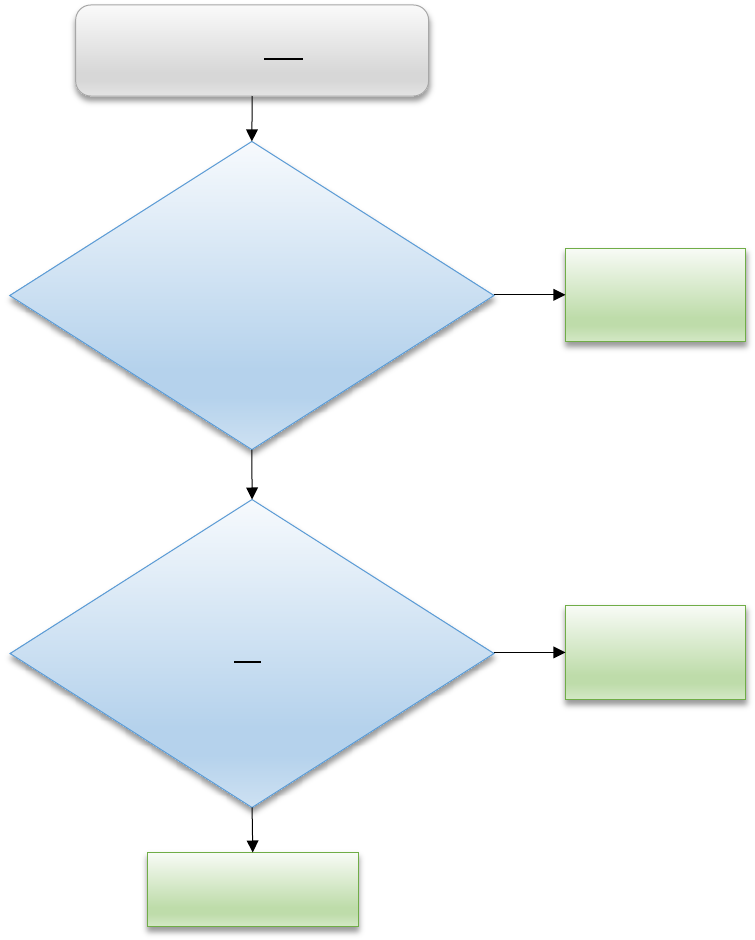
21
Paragraph (1): Of a Type
The following decision tree recommends a thought process in making a CID under paragraph (1) of the FAR
2.101 commercial item definition for “of a type.”
When deciding if a proposed item satisfies the definition to be deemed a commercial item, an evaluation of a
similar (i.e., of a type) item is permitted. The definition does not require that the exact proposed item must be
sold or offered for sale to non-Government customers.
NO
NO
YES
YES
Is the proposed item “of a
type” (similar to a commercial
item) that is customarily used
by the general public or by
nongovernmental entities for
nongovernmental purposes?
Commercial under
paragraph (1)
Not commercial
under
paragraph (1)
Paragraph (1) definition:
Define product AND identify
product’s functionality and purpose
Has proposed item been:
(i) Sold, leased, or
licensed to the general
public; OR
(ii) Offered for sale, lease,
or license to the general
public?
Not commercial
under
paragraph (1)

22
NOTE: The ability to consider similar items embraces DoD’s broader view of the types of items that
may qualify as commercial and gives consideration to products and services offered by both
traditional and non-traditional defense contractors.
The “of a type” language in the FAR definition provides broad latitude to contracting officers in arriving at their
CIDs. This is meant to encourage acquisitions of commercial items by the Department that do not fulfill the
well-defined COTS category, yet are similar to items available commercially. The definition is applied when
ascertaining whether items sold or offered for sale to the general public are present in the marketplace, and are
similar to those offered to fulfill the Government requirement. This perspective provides the broad discretion
granted to contracting officers pursuant to the principles laid out in FAR 1.102(d) and at FAR 1.102-4, which
call for contracting officers to exercise sound business judgment in interpreting and applying regulations.
Form, fit, and function. A search of this phrase revealed that the terms are rooted in statute in association with
rights in technical data, not with commerciality. The terms are not associated with the definition of commercial
item and the “of a type” phrase.
How does that affect CIDs? The phrase “form, fit, and function” is frequently seen in discussions of
commercial of a type items because they are a useful means to compare two items.
Form, fit, and function describe the essential characteristics that define a product.
• Form refers to the physical characteristics of the item, such as the physical shape, size, material and
weight. Form expands to the manufacturing process, packaging and handling requirements, and any
specialized coatings.
• Fit refers to the interface of the item with other systems and to any installation requirements. Form and
fit can help support price analysis, but the function of an item is vital to support a commerciality
determination.
• Function is the essential purpose of the part. For example, is the primary purpose for the Government
item military-unique?
When making the of a type judgment, consider the context of the products and industry practices in customizing
commercial items. While functionally interchangeable items may not be exactly alike, these differences do not
automatically mean that they should be considered modifications. Consideration must be given to conditions
common to the technology, product or service. For example:
• If a car is different color, it is still functionally interchangeable and may be considered of a type.
• If a safety harness jacket is one of several sizes offered, it is of a type.
• If a communication device offers different frequencies, modes, or memory, it is of a type.
NOTE: Form, fit, and function may be used to compare two items, but the terms are not legally
determinative of commerciality or commercial of a type items. That is, form, fit, and function cannot
be the only basis to determine that an item is commercial of a type.

23
Questions to Consider
To determine whether an item is “of a type,” you should consider the following:
• What are the essential physical characteristics of the Government’s “of a type”
requirement, and how does it compare to the commercial items?
• As items become substantively less similar, there is less reason to treat it as
commercial.
• Is the primary purpose of the item to be procured a non-Governmental (commercial)
purpose? If no, then it is not likely commercial.
• Is the “of a type” item coming down the same production line as the commercial
item?
Application
All helicopters have an Automatic Direction Finder (ADF) Antenna. The version of ADF
Antenna used on Black Hawk helicopters is of a size and shape not used by other helicopters
and there are no non-governmental sales of that specific part number. However, several
vendors sell similar ADF Antennas in the commercial marketplace in substantial quantities
for the same purpose. After comparing the form and function of the antennas, the ADF
antenna was deemed commercial even though the exact same antenna is not sold in the
commercial marketplace.
Another example of a commercial product not sold in the commercial marketplace would be
a computer that has a case ruggedized for use in the field.
Key Concepts
Sales of a commercial of a type item to the “general public” do not include sales to the Federal, State,
local, or foreign governments (or through foreign military sales (FMS)).
By deliberately developing requirements that accommodate of a type commercial items, the Government
can increase competition and reduce cycle time through consideration of items already available from
considering commercial offerors as well as defense contractors that develop proprietary items.
There is usually no bright-line for making a CID in of a type scenarios. The comparison between the
Government’s requirements and available commercial items must account for differences in the
functions to be performed, performance required, and essential physical characteristics.
This guide has provided a decision tree describing a thought process to help the contracting officer make
logical, consistent determinations for of a type items, but it cannot provide for every consideration.
Each process should also take into account issues specific to the item.

24
Practical Example No. 1
Paragraph (1) – Of a Type
Objective: Commercial items classified as of a type require understanding the commercial item
paragraph (1) definition and may include a comparison between the item being
procured and the commercial item equivalents.
Background: The Marines are buying auxiliary power units (APU) for a ground/sea vehicle that
provides a high power-to-weight capability. The APU needs to be quiet, but
ruggedized for the operating conditions. The offeror submitted a CID package that
asserts commerciality of multiple model numbers in a product family that have both
commercial and military applications.
Analysis: The offeror’s CID provided that the APUs are sold and offered for sale
commercially and have been or can be adapted to fit both commercial and military
applications. All of the APUs are manufactured, assembled and tested in the same
facility using the same personnel, policies, processes and procedures in both
commercial and Government application. Each of the APUs consists of groups of
closely related models using the same core machinery and power levels.
The analyst conducted market research and identified both military and commercial
vehicles that contain APUs. The offeror provided multiple comparisons between
different APUs sold to both military and commercial customers. The analyst was
fortunate to obtain the technical drawings and a bill of materials for the subject
APUs and commercial equivalents. (It should be noted that contractors generally
are not required to provide this type of cost element detail for commercial items and
usually should not be asked to provide it.) In the comparison analysis, the analyst
identified relatively minor differences between the commercial equivalents and the
proposed APUs.
Results: After evaluating the CID package, performing market research and comparing
commercial APUs equivalents to the proposed APUs, the team recommended the
APU are of a type customarily available in the commercial marketplace. The APU
is not significantly different than a currently available commercial variant, and in
many respects, are identical in form and fit, and both have the same function. The
requirement for quiet, but ruggedized features is highly desirable in the
marketplace and is a standard add-on feature available in the commercial market.
Takeaways: Understanding the offeror CID assertions and conducting independent market
research will aid you in validating the offeror CID assertions and provide
insight into commercial item comparisons.
Of a type commercial items can be difficult, but comparing the proposed item
to the commercial market will allow you to identify variations to form, fit,
and function.
When customizing your requirements, pay attention to standard practices in
the industry. Ask yourself key questions, such as whether terms and
conditions, such as additional inspection and testing above and beyond the
commercial marketplace, are necessary.
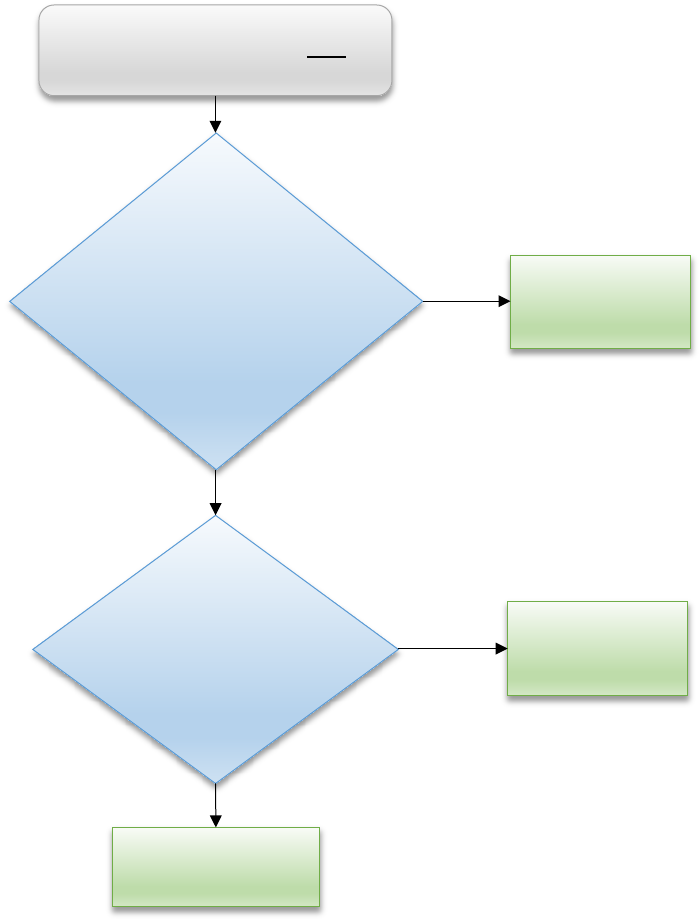
25
Paragraph (2): Items Evolved from a Commercial Item (Supply or Service)
The following decision tree recommends a thought process in making a CID under paragraph (2) of the FAR
2.101 commercial item definition for “items evolved from a commercial item.”
The definition of a commercial item only requires an item to be offered for sale to the general public; therefore
the ratio of Government to non-Government sales is irrelevant when determining commerciality. However, the
ratio may be relevant to determine a fair and reasonable price, as addressed in Part B of this Guide. If an item
meets the first two requirements of paragraph (1), but has not yet been offered for sale to the general public, it
may still be commercial. It must meet three basic requirements:
• The item you are considering must have evolved from an item (either a supply or a service) fitting the
definition in paragraph (1) due to improvements in technology or performance.
NO
NO
YES
YES
Did proposed item evolve
from any item described
in paragraph (1) through
advances in technology
or performance that’s not
yet available in the
commercial marketplace
per paragraph (2)?
Commercial under
paragraph (2)
Not commercial
under
paragraph (2)
Paragraph (2) definition:
Define product or service AND
identify functionality and purpose
Will the item be in the
commercial
marketplace before it
is delivered under
your contract?
Not commercial
under
paragraph (2)

26
• Services evolve just as readily as supplies, and related services follow the evolution of supplies. This
frequently applies to services under paragraph (5) of the FAR definition of a commercial item; as
supplies evolve, so must the installation, maintenance, and repair of those same items (e.g., maintenance
of software).
• The item you are considering generally will be in the commercial marketplace before it is delivered
under your contract.
Questions to Consider
To determine whether an item evolved from a commercial item, you should consider the
following:
• Did the item evolve from a paragraph (1) item, due to improvements in technology or
performance?
• Is this a newer version of something that you can already buy commercially?
• If so, is the prior version commercial because it meets all the requirements of
paragraph (1)?
• Is the difference for some reason other than technology or performance
improvements?
• Will the item generally be in the commercial marketplace before it is delivered under
a DoD contract?
• Will the item be commercially available by the time that you need it delivered?
• How far along is the item in the development process? Has there been a successful
prototype?
• How far along is the development of the manufacturing process? Has the assembly
line been purchased? Established? Tested? Are there pieces of equipment remaining
to be assembled?
• If the item will not be available on or by the delivery date of your contract, are there
presales to the general public?
Application
Items meeting this part of the definition are usually a new model of an existing commercial
product, a product upgrade, or a new version. Some common examples of evolving
commercial technologies include: heavy trucks, off-road equipment, and construction
vehicles; nanotechnology; surveillance systems; integrated circuits; composites; satellites;
lithium-ion and other types of battery cells; personal protective equipment (including
armor); and software.
27
Key Concepts
Absent compelling evidence to the contrary, items evolving from a commercial item will be presumed to
be commercial.
The classified nature of an item does not in and of itself restrict the item from meeting the evolved
commercial item definition. An item that has evolved from a commercial item is one that may have a
classified component or use. For example, an evolved commercial item may be used as a component in
a classified, military assembly.
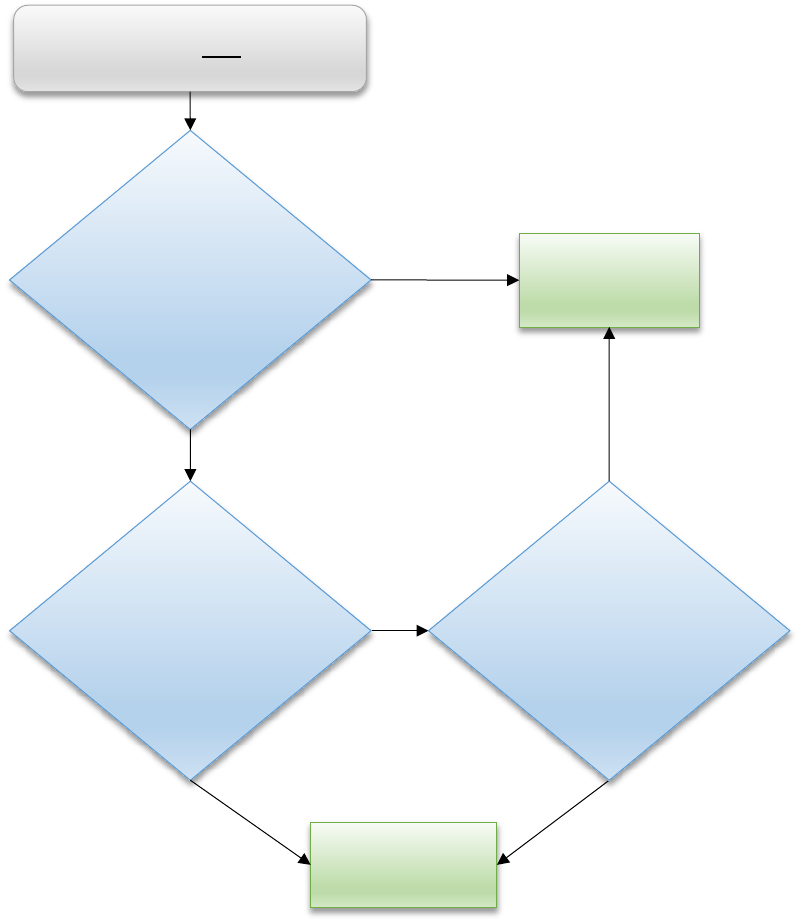
28
Paragraph (3): Modified Items (Products and Services) of a type
The following decision tree recommends a thought process in making a CID under paragraph (3) of the FAR
2.101 commercial item definition for “modified items (products and services) of a type.”
Any item that would satisfy a criterion expressed in the “of a type” or “evolved” sections of this definition, but
for:
• Modifications of a type customarily available in the commercial marketplace; or
YES
NO
NO
NO
YES
YES
Does the proposed
item meet the criteria
in paragraph (1) or
(2), but include
modifications?
Commercial under
paragraph (3)
Not commercial
under
paragraph (3)
Paragraph (3) definition:
Define product AND identify
product’s functionality and purpose
Does the proposed
item have
modifications that are
customarily available
in the commercial
marketplace?
Does the proposed
item have minor
modifications “of a
type” not customarily
available in the
commercial
marketplace?

29
• Minor modifications of a type not customarily available in the commercial marketplace made to meet
Federal Government requirements. Minor modifications mean modifications that do not significantly
alter the nongovernmental function or essential physical characteristics of an item or component, or
change the purpose of a process. Factors to be considered in determining whether a modification is
minor include the value and size of the modification and the comparative value and size of the final
product. Dollar values and percentages may be used as guideposts, but are not conclusive evidence that
a modification is minor.
Many markets allow for customization and modification as a standard commercial practice. In addition, the
minor modifications of a commercial product to allow the product to be used in a DoD application do not limit
the product from being considered a commercial item.
Questions to Consider
To determine whether a modification is of a type modification, you should evaluate the
following:
• How similar is the modified item to other modified items sold in the commercial
marketplace?
• If there are no similarities, the mod is likely not of a type.
• Does the supplier perform similar modifications for non-Government customers?
• If not, the modification is likely not of a type.
• Are there differences in the manufacturing processes used to perform the
modification for the Federal Government and non-Government customers?
Application
Examples include products that are customized commercially (such as automobiles, heavy
equipment, and computer systems) and products with DoD unique modifications that do not
change the essential use and purpose of the product. Therefore, modified products can meet
the commercial item definition as long as the modifications meet one of the two following
tests:
• Modifications of a type Customarily Available in the Commercial Marketplace.
Many companies routinely customize products for their customers in the commercial
marketplace. In fact, the modifications can be extensive and still meet this part of the
definition.

30
For example, the commercial derivative aircraft for the Navy’s P-8 is a modified
version of the Boeing 737-800 ERX commercial aircraft. Aircraft used by
commercial logistics carriers are heavily modified versions of passenger aircraft used
by commercial airlines. Nevertheless, the contracting officer must verify the
modification because the aircraft, may have been so extensively modified, that they
are not considered commercial items.
• “Minor” Non-Commercial Modifications to Meet Federal Government-Unique
Requirements.
Minor Modifications can be as simple as a color change. For instance, a review was
done on an active vibration control (AVC) mechanical unit (MU). During the review,
the supplier was able to provide documentation to show the commercial item and the
DoD Item to be identical except for the color of the unit.
Another example of a minor modification that would not impact the commercial
nature of the product is buying a commercial passenger airplane and then mounting
sensory equipment in the interior and on the exterior of the plane to detect something
on the ground.
Other examples include: modifications to a commercial product so that it can connect to a
major weapon system; addition of a different casing to protect from electromagnetic pulse;
and addition of redundant parts to improve reliability, etc. One must consider and
understand the value and size of a modification and whether it changed function/essential
physical characteristics in arriving at the conclusion. The DCMA CIG and other functional
specialists are available to assist the contracting officer in this regard.
Key Concepts
The modification of a type should be evaluated to determine if it is a modification customarily available
in the commercial marketplace or if it is a minor non-commercial modification.
Consider the following:
o Similarity to other modified items sold in the commercial marketplace;
o Supplier customarily performs similar modifications for non-government customers; and
o Supplier uses similar manufacturing processes to perform the modifications for both the Federal
government and non-government customers.
Practical Example No. 2
Paragraph (3) – Modified Items (Products and Services) Of a Type

31
Objective: It is important to evaluate the CID provided by the offeror for subcontract
items to understand the item being procured and any associated differences
in the functions to be performed, performance required, and essential
physical characteristics.
Background: The offeror provided a proposal for a radio system, specific to a military
need. The offeror claimed the radios were COTS items; however, the prime
contractor did not provide documentation to substantiate they made a
reasonable business judgment in determining the item commercial. The base
radio was a complex VHF radio that existed in the commercial marketplace.
The proposed base radios were equipped with the ability to accept the
encryption add-on quickly. The base radio offered a limited level of
security, such as frequency hopping technology. Frequency hopping is a
technology that exists in the commercial marketplace, and is regulated.
Frequency hopping limits the number of channels jumped and how fast they
can be jumped. Cell phones use this capability. Assume this effort is sole
source for the purpose of this example.
Analysis: Upon receipt of the proposal, the reviewer requested the offeror provide their
commerciality determination. The offeror did not provide the required
support to determine if the product meets the definition of commercial. The
reviewer worked with the offeror to illustrate a template of what should be
included.
Further inquiry resulted in learning the following:
• The radios were offered to the Government as a base unit, with an
optional encryption system.
• While the base radio was offered to the general public, the encryption
system was not offered to the general public.
Preliminary findings indicated that this was not a COTS item. The offeror
changed the assertion of the base radio to of a type and the encryption add on
to “minor modification”.
The review team analyzed the base radio to determine if it was of a type and
conducted market research to determine whether the encryption system was
a minor modification. The encryption system had the ability to be toggled,
and when switched on, allowed for secure communications to an aircraft.
Based on market research and assistance from engineering, the review team
determined that the commercial marketplace had no need or use for the level
of encryption being proposed. The encryption modification was not offered
in the general public and was double the cost of the base radio.
Results: The contracting officer determined the base radio to be a commercial
product; however, the add-on encryption was not determined to be
commercial because:
• It was not customarily available in the commercial marketplace; and
• Its cost exceeded the criteria for minor modification.

32
Since the add-on was not commercial; the capability of the proposed base
radio to accept the encryption add-on was not commercial; therefore, FAR
15.403-1(c)(3) applied. Additionally, the contracting officer determined the
modification was not minor. The modification was not exempt from the
requirements for submission of certified cost or pricing data.
Takeaways:
The offeror should determine whether the products and services meet
the definition of a commercial item. The offeror should provide the
commerciality assertions to the contracting officer when requested for
review.
The contracting officer should evaluate the modification as a two-part
test to determine:
o If it is a modification that is customarily available in the commercial
marketplace or;
o If it is a minor non-commercial modification to meet the government
unique requirements.
Practical Example No. 3
Paragraph 3 - Preliminary Market Research is Inconclusive as to Commerciality
Objective: When preliminary market research is inconclusive as to commerciality, it is
incumbent on the offeror to provide substantiation for a commercial item
determination.
Background: The contracting officer, with the assistance of technical staff members and
DCMA CIG industrial engineers, reviewed the product specification sheet,
and determined that modifications were required to enable commercially
available products to withstand severe vibrations. The contracting officer
could not determine whether the modifications were minor, as defined in
FAR 2.101(3)(ii).
Analysis: The contracting officer reached out to DCMA CIG to determine if the
American National Standards Institute (ANSI)/Electronic Industries Alliance
(EIA) S/B EIA 649, the National Consensus Standard for Configuration
Management definition of nonminor modification met the FAR 2.101
definition of a nonminor modification. Per the ANSI/EIA S/B EIA 649
definition, a change to key product specifications is a non-minor
modification. However, the FAR 2.101 definition focuses on whether the
change is to a “purpose,” “physical characteristic,” or “function.” DCMA
CIG conducted a technical analysis of the modification and advised that the
modification might be a non-minor modification based on the physical
characteristics and function of the item. Market research efforts concluded
that the nonminor modification may be available in the commercial
marketplace, but data was inconclusive.

33
The contracting officer reached out to the offeror to provide additional
support. The offeror asserted the item was commercial; requested FAR Part
12 procedures; and claimed exemptions from TINA certification
requirements pursuant to FAR 15.403-1(c)(3). The offeror did not provide
the contracting officer any supporting data but stated, “This is a brake and
brushing assembly. Brake and brushing assemblies are sold in the
commercial marketplace. Therefore, this is a commercial of a type sold in
the commercial marketplace.”
The contracting officer was not convinced that it was of a type and sent a
follow-up e-mail requesting the offeror to: “Please provide within 10
business days sufficient data to conclude any modifications between
commercial and Government model are minor. ” The offeror acknowledged
receipt of the contracting officer request but failed to provide the requested
information.
Results: The contracting officer considered all information submitted and determined
that there was insufficient information to conclude the item was commercial,
and that FAR Part 15 procedures applied.
Takeaways: When the contracting officer takes the appropriate steps to determine
commerciality and the offeror does not support the commerciality assertion,
the contracting officer may determine the item not commercial and use FAR
Part 15.
Paragraph (4): A Combination of Commercial Items
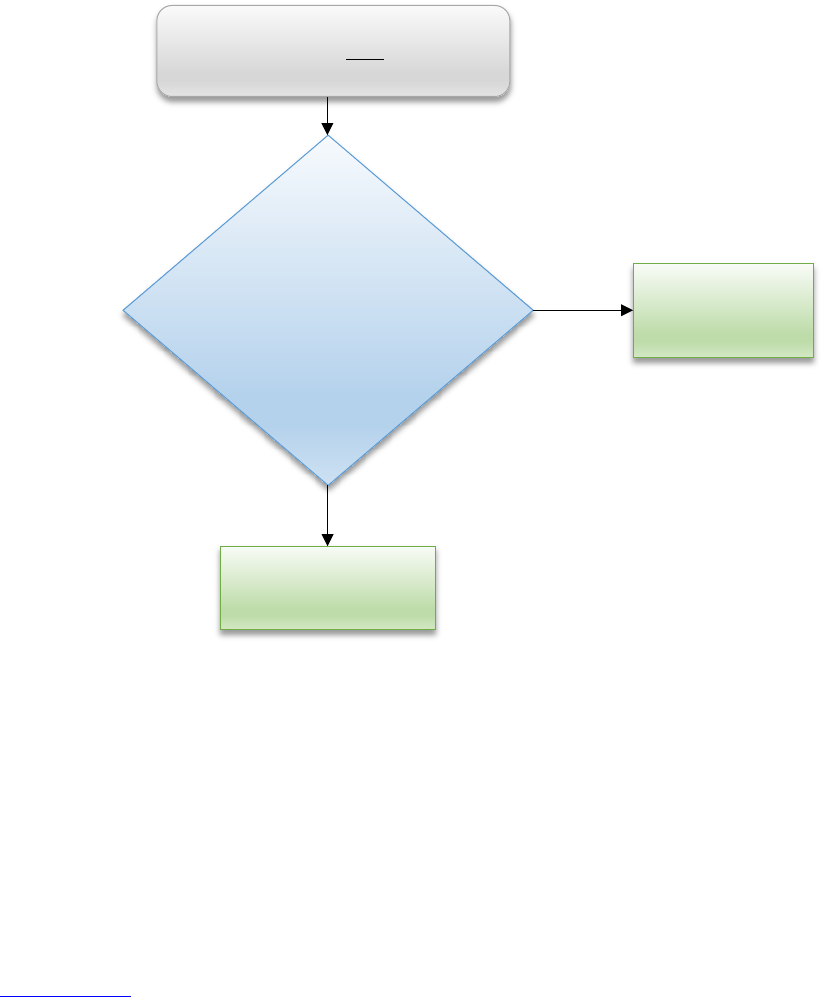
34
The following decision tree recommends a thought process in making a CID under paragraph 4 of the FAR
2.101 commercial item definition for “a combination of commercial items.”
Commercial items may be combined to produce something that is not commercial. However, in most instances,
a combination of commercial items or services will result in a commercial item. Indicators the item may still be
commercial are:
• The physical components are a combination of a paragraph (1), (2), or (3) commercial items.
• The services used to produce the non-commercial end item is a paragraph (5) commercial item. (See
Paragraph (5): Support Services for an Item (Commercial Product))
Application
NO
YES
Is the proposed product
a combination of items
that meets the
requirements of
paragraphs (1), (2), (3),
or (5)?
Commercial under
paragraph 4
Not commercial
under
paragraph (4)
Paragraph (4) definition:
Define product AND identify
product’s functionality and purpose

35
An example of a combination of commercial items would be a computer network that uses
commercially available hardware and software and uses a commercial help desk. The
combination of the commercial hardware, software, and professional services render the
computer network commercial because the components are commercial.
Key Concepts
In most instances, a combination of commercial items will result in a commercial item, but not every
single component in an end item must be commercial for the item to be commercial. However, non-
commercial components may or may not render an item non-commercial, depending on the number and
significance of noncommercial parts. The contracting officer, with assistance of technical specialists,
needs to determine whether or not the combination results in a commercial item. The same logic would
apply to services.
FAR 52.244-6(b) specifically requires, to the maximum extent practicable, contractors to incorporate,
and require its subcontractors at all tiers to incorporate, commercial items or NDIs as components of
items to be supplied.
CIDs for subcomponents and spare parts of items determined to be commercial must be considered
independently.
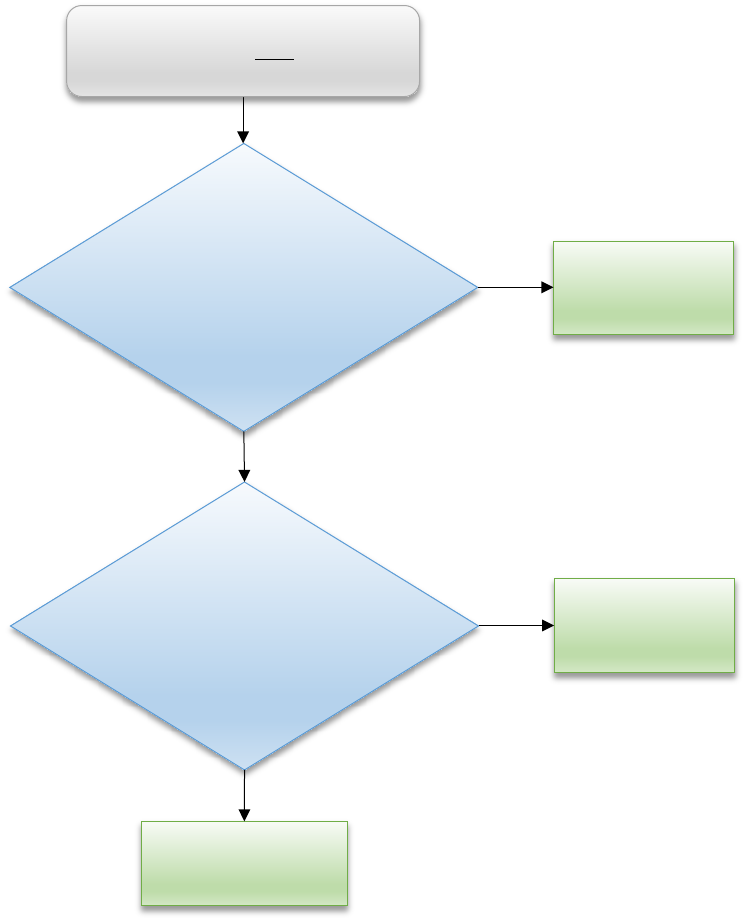
36
Paragraph (5): Support Services for an Item (Commercial Product)
The following decision tree recommends a thought process in making a CID under paragraph (5) of the FAR
2.101 commercial item definition for “services to support a commercial item.”
This paragraph covers installation, maintenance, repair, and training services to support commercial or
commercial of a type items. Support services of any type may be commercial items. In order for these services
to be commercial though, they must meet two basic requirements:
• The offered service is procured for support of a commercial product referred to in paragraph (1), (2), (3),
or (4) of the commercial item definition. You will first need to complete or obtain the previous CID on
the product that the offered service is supporting.
NO
NO
YES
YES
Are the services for support
of a product that meets the
requirements of paragraph
(1), (2), (3), or (4)?
Commercial under
paragraph (5)
Not commercial
under
paragraph (5)
Does the source of the
offered services currently
provide similar services to
the general public under
terms and conditions similar
to those offered to the
Government?
Not commercial
under
paragraph (5)
Paragraph (5) definition:
Define product AND identify
product’s functionality and purpose

37
• The service provider also currently provides similar services contemporaneously to the general public
under terms and conditions similar to those offered to the Federal Government.
Questions to Consider
The offered service is procured for support of a commercial product referred to in paragraph
(1), (2), (3), or (4) of the commercial item definition.
• Is the item being serviced commercial or commercial of a type?
• Does the offered service support any product that isn’t a paragraph (1), (2), (3), or (4)
commercial product?
• Are there noncommercial products that are supportable by commercial services? If
so, which is preferable:
o Perform two separate acquisitions, only one of which can use FAR Part 12; or,
o Combine the acquisition into one contract action that doesn’t use FAR Part 12 at
all?
o Use a hybrid contract with noncommercial and commercial CLINs.
In order to meet this paragraph of the definition, the contractor also must provide similar
commercial services contemporaneously to the general public under terms and conditions
similar to those offered to the Federal Government.
• Does this specific provider have commercial clients? Do the commercial clients
receive services similar to the proposed services from the contractor?
• When was the last time that the contractor provided the service? The contracting
officer will need to make a judgment call regarding continued relevance.
• Compare the proposed terms and conditions to the current commercial service’s term
and conditions.
o How do they differ?
o Why do they differ?
o Would the commercial customer adjust the terms and conditions in the same
manner?
• Are the performance incentives in the commercial marketplace similar to those
offered to the Government (customer satisfaction, number and duration of
connectivity outages, etc.)?
• Are the warranty terms available in the commercial marketplace similar to those
offered to the Government?
• Are there costs associated with using the warranty (e.g., if not reported within 15
days of first use)?
• Are there any Government-unique liability concerns (e. g., a hazardous work
environment) that would affect the terms and conditions of the service?

38
• Are there any Government-unique situations that protect the offeror from risk, or
expose the offeror to more risk?
The contracting officer will need to exercise his/her judgment to determine if the terms and
conditions to the general public are similar on the whole.
Application
The Navy was considering issuing to the original equipment manufacturer (OEM) a follow-
on, sole source sustainment services contract for a support equipment for an aircraft.
Although the aircraft was acquired as a FAR Part 15 contract, the support equipment was of
a type sold in the commercial marketplace.
Concerned with the escalating costs of this expensive services contract for commercial parts
of the aircraft, the contracting officer extended her market research. She discovered that
another contractor had performed sustainment services for support equipment of a type sold
in the commercial marketplace. With this evidence, the Navy competed a FAR Part 12
contract. The other offeror won the contract and provided sustainment services within the
same schedule and at a significantly reduced price.
NOTE: Many sustainment services for a noncommercial aircraft under FAR Part 15 can be commercial
and can benefit from competition if the components to be serviced are commercial or commercial of a
type items and the services are offered to the general public contemporaneously (i.e., at the same time)
under similar terms and conditions.
Key Concepts
Assess whether the item being installed, repaired, maintained, or used for training is in support of a
commercial or commercial of a type item.
Consider alternative, commercial sources of support services to compete. Are these services offered
contemporaneously to the general public under similar terms and conditions?
Commercial services also can apply to nontangible items such as knowledge based services.
NOTE: In some situations DoD may have planned to use terms and conditions that are not similar to
those used in the commercial marketplace. Before rejecting alternative terms and conditions, the
acquisition team must consider whether the commercial terms and conditions can be used and still
meet mission needs.
Practical Example No. 4
Paragraph (5) - Commercial Market Terms and Conditions

39
Objective: Understand the principle of commercial services procured in support of commercial
items and the importance of ensuring the Federal Government receives similar terms
and conditions offered to the general public for such services.
Background: The Air Force solicited bids for maintenance, repair & operations (MR&O) services
for a cargo aircraft located at a CONUS installation. An Air Force contracting officer
recently had determined the engines used on the aircraft are commercial items with
minor modifications per paragraph (3)(ii) of the FAR 2.101 commercial item
definition and, therefore the USAF searched for a commercial vendor to service these
engines while stateside.
Operating out of a commercial airport, was a small business that provided MR&O
services for turbine engines to many commercial airlines. Beta Aviation submitted a
FAR Part 12 proposal asserting their MR&O services were commercial based on
paragraph (5) of the definition. A summary of the proposal is below.
Beta Aviation submitted the following FAR Part 12 proposal to provide
MR&O services to a fleet of 30 trainer aircraft. Beta Aviation had over 20
years of experience providing MR&O services to multiple commercial airlines
with similar aircraft that also used the same engine. Beta Aviation asserted
these services were commercial based on paragraph (5) of the FAR 2.101
definition and offered to provide the following standard MR&O services at a
fixed price per year, except where noted:
• All scheduled maintenance as outlined in the applicable maintenance
manual (oil changes, hydraulic fluid changes, stationary seal
replacement, shaft and turbine blade inspections where visible);
• Major overhaul every 1,000 hours to include complete disassembly and
internal inspection of each engine and repairs where necessary (drum
inspections, rotor inspections, disk inspections, diffuser and exhaust
cleaning);
• All unscheduled maintenance and repairs; and
• All MR&O work completed by Federal Aviation Administration (FAA)-
certified maintainers using FAA-approved parts.
Analysis: The contracting officer’s market research identified similar services regarding regular
overhaul intervals; however, commercial terms and conditions were insufficient to
meet Government requirements regarding unscheduled maintenance and repairs. The
contracting officer reviewed the proposal and conducted market research on the
service proposed to understand whether the paragraph (5) of the definition was
satisfied. Paragraph (5) requires two conditions to be met for services to be
considered commercial:
1. The service is procured for support of a commercial item (meets paragraphs (1),
(2), (3), or (4) of the FAR 2.101 definition), but not necessarily from the same
source, AND
2. The source of the service currently provides similar services to the general public
under similar terms and conditions.
The contracting officer paid particular attention to the criteria for comparing terms
and conditions and documented the criteria and standards.

40
Results: The engine was determined to be a commercial item by a USAF contracting officer as
defined in paragraph (3)(ii) of the commercial item definition, so criteria 1 was
satisfied. The contracting officer also confirmed that Beta Aviation performed
planned maintenance for engine MR&O services on similar aircraft for commercial
clients on a similar basis. However, the Government’s requirements for unplanned
maintenance and repairs were more stringent than the commercial terms and
conditions. Since the terms and conditions were not similar, the proposed service
failed to meet criteria 2 of the definition, and, therefore, was determined to be not
commercial; the aircraft required military unique MR&O services that should not be
procured as commercial services.
Takeaways: The DoD mission requires many services that are similar to those commercially
available, but the military unique requirements may drive the need for additional
services other than are customarily available to the general public.
Suppliers may try to limit their risk by imposing different terms and conditions
on the Government for the services they provide. The analyst needs to
understand exactly what the terms and conditions are so the correct
recommendation can be made.
Furthermore, the contracting officer, in concert with the requirements
community, should assess the need for terms and conditions that differ from the
commercial standard to differentiate between those that are required for flight
safety and those that may be merely traditional.
Practical Example No. 5
Paragraph (5) - Commercial Services
Objective: When evaluating commercial services, it is important to understand the proposed
service and its functionality, labor skill mix, and task to be completed.
It is the contracting officer’s responsibilities under FAR 15.403-1(c)(3) to determine
whether a particular item or service meets the definition of a commercial item, and to
require contractors to provide to the Government documentation that establishes the
type of subcontractor commercial service that is being proposed (i.e., maintenance,
repairs, training or other services) as defined by FAR 2.101:
(5) Installation services, maintenance services, repair services, training services, and
other services if--
(i) Such services are procured for support of an item referred to in paragraph (1),
(2), (3), or (4) of this definition, regardless of whether such services are
provided by the same source or at the same time as the item; and
(ii) The source of such services provides similar services contemporaneously to the
general public under terms and conditions similar to those offered to the Federal
Government;

41
This CID package should contain a breakdown of the proposed services and how these
services support a commercial item/product.
Background: A Navy aircraft carrier hangar deck elevator is critical to aircraft readiness because it
moves the aircraft up to the flight deck for flight operations or down to the hangar deck
for maintenance and repair. The aircraft elevator is close to a one-of-a-kind item that
is designed to move significant size and weight. If it does not work, the carrier’s
readiness is immediately impaired. The hangar deck elevator was installed as part of
the initial shipbuilding program, a FAR Part 15 contract. It was procured from a
commercial sole source supplier that installed it and provided maintenance services.
The response time for maintenance of the hangar deck elevator had been unsatisfactory
because the contractor’s technical representatives needed to fly to distant locations for
unplanned repairs, resulting in cancellation or unacceptable delay of missions. The
aircraft carrier maintenance officer responded by training engineers to conduct ad hoc
repairs as an additional duty, but this solution resulted in uneven maintenance. Market
research discovered that, contrary to common understanding, large commercial
container cargo ships used similar elevators that could be considered commercial. The
Navy issued a request for information, received positive responses, and decided to
compete the follow-on contract. After solicitation release, the Navy received 3
responsive proposals and one offeror was selected.
The successful offeror submitted a proposal to provide subcontracted maintenance
services supporting the Navy’s contract. The offeror indicated that commercial cargo
ships also utilized large, industrial elevators to convey heavy equipment from one floor
to another as the Navy’s hangar deck elevator does. The offeror included a CID for the
elevator that reflected the proposed maintenance services that would include: 24-hour
technical support by technical reps who would augment the crew on extended
deployments; scheduled site visits to inspect the elevators quarterly; three-hour turn
around for unscheduled repairs; scheduled site visits to inspect the hangar deck
elevator engines; support cables, and hydraulic systems. The offeror considered these
services to be standard within the commercial marketplace and that the proposed
maintenance services for this Government contract to be no different than maintenance
services that would be performed on similar equipment within the commercial
marketplace.
Analysis: The contracting officer concluded that the hangar deck elevator was commercial of a
type, and the maintenance services to be commercial. A commercial contract would
mitigate equipment failure risk and emergency repair work. The contracting officer
verified that these types of maintenance services are found contemporaneously in the
commercial marketplace.
Terms and Conditions: Market research identified that large elevator maintenance
services are contingent on contract term (period of performance), number of
equipment pieces being serviced, physical equipment locations (multiple locations vs.
single location) and scope of work requirements. The few differences in terms and
conditions were related to mission: equipment required to maintain elevator balance
within one degree and two tech reps to augment the crew on extended deployments.
The contracting officer noted that the government-specific terms and conditions
would result in adjustments to market research pricing and passed this information to
the DCMA analyst.

42
Since the analyst was not able to make an “apple-to-apple” comparison with
prevailing market conditions, the contracting officer submitted fact finding questions
(FFQs) to the offeror. The FFQs included a request for a detailed breakdown of each
of the maintenance services proposed, project schedule identifying the number of
personnel supporting these services, the period of performance/frequency for each
service, and locations where these maintenance services are proposed. In addition, the
government also requested copies of all invoices or contracts where this subcontractor
has performed like/similar maintenance services within the commercial marketplace.
Results: The offeror submitted a detailed response outlining all requested information
pertaining to the proposed maintenance services. The analyst was able to cross
reference and make a comparison between the proposed services found during market
research and against invoice copies furnished by the subcontractor to commercial
companies for like/similar services. The analyst verified that, although this is a
specialized field, the services were recommended and like/similar to those services
offered in the commercial marketplace. The analyst recommended the proposed
maintenance services as commercial services based on the specific requirements
contained within the Statement of Work.
The Navy was able to compete the contract for services using FAR Part 12, even with
somewhat differing terms and conditions. The Navy was able to improve response
times to maintain readiness at a lower price.
Takeaways: Don’t hesitate to request additional information or clarify information contained
within the proposal or supporting documentation if necessary to support the
analysis. Without this information, a recommendation may not be able to be
made, as all relevant variables/factors may not have been accurately assessed or
considered. In this example, without the additional information furnished by the
offeror in response to the analysts’ fact finding questions, a DCMA
recommendation for commercial services may not have been achieved.
It is critical to cross reference and identify that these “services” can be performed
either in exactly the same manner between government and commercial contracts,
or identify the differences in terms and conditions.
Documentation and communication are critical to ensure that any differences in
terms and conditions are reflected in price analysis.
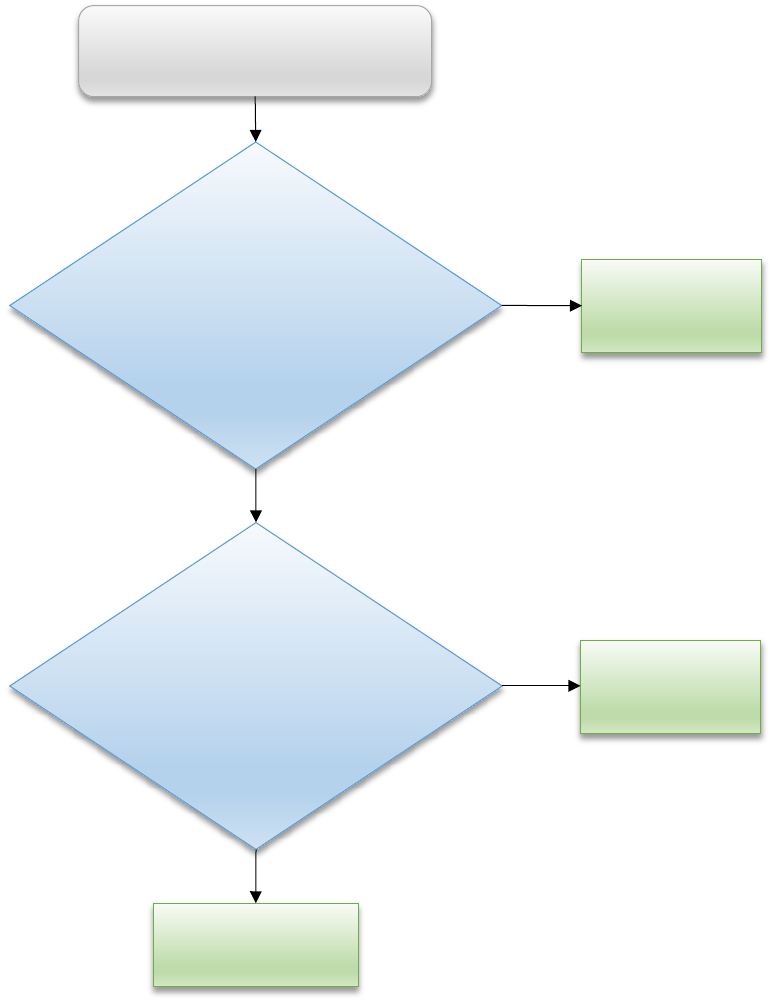
43
Paragraph (6): Services of a type
The following decision tree recommends a thought process in making a CID under paragraph (6) of the FAR
2.101 commercial item definition for “services of a type.”
NO
NO
YES
YES
Are the services “of a type”
(similar to a commercial
service) offered and sold
competitively in substantial
quantities in the commercial
market place based on
established catalog or
market prices?
Commercial under
paragraph (6)
Not commercial
under
paragraph (6)
Paragraph (6) definition:
Define services
Are the services for specific
tasks performed or specific
outcomes to be achieved and
under standard terms and
conditions?
Not commercial
under
paragraph (6)
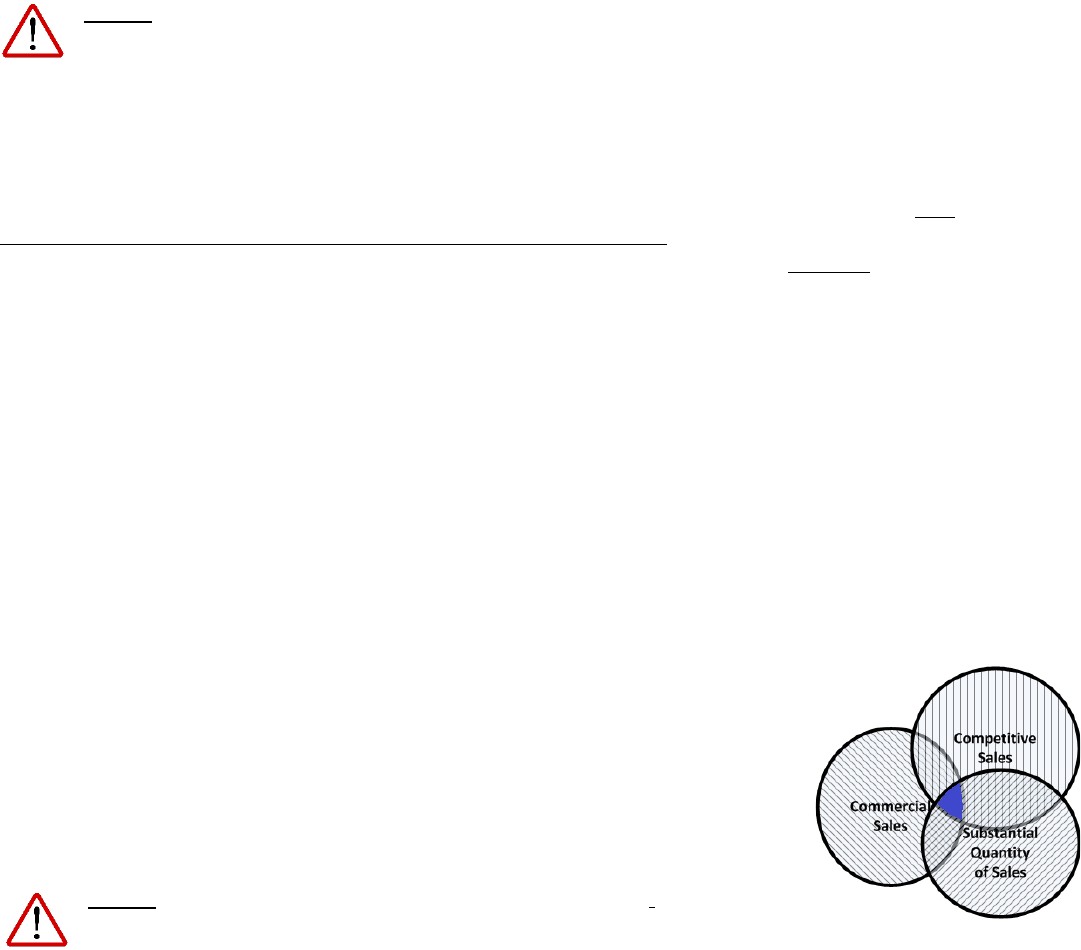
44
NOTE: 41 U.S.C. 103(6) defines commercial services as “services offered and sold competitively, in
substantial quantities, in the commercial marketplace based on established catalog or market prices for
specific tasks performed or specific outcomes to be achieved and under standard commercial terms and
conditions;” Although FAR 2.101 paragraph (6) added “services of a type,” the most critical element of this
definition of commercial services is that the service must be offered and sold competitively, in substantial
quantities, in the commercial marketplace.
Paragraph 6 of the FAR definition of commercial item addresses services of a type offered and sold
competitively in substantial quantities in the commercial marketplace based on established catalog or market
prices for specific tasks performed or specific outcomes to be achieved and under standard commercial terms
and conditions. For purposes of these services –
1. “Catalog price” means a price included in a catalog, price list, schedule, or other form that is regularly
maintained by the manufacturer or vendor, is either published or otherwise available for inspection by
customers, and states prices at which sales are currently, or were last, made to a significant number of
buyers constituting the general public; and
2. “Market prices” means current prices that are established in the course of ordinary trade between buyers
and sellers free to bargain and that can be substantiated through competition or from sources
independent of the offerors.
Catalogs must be published or available to the general public. When making a determination based on
commercial catalog pricing, it is necessary to verify the services are being offered and sold competitively in the
commercial marketplace to the general public in substantial quantities. The mere fact that a service appears in
a catalog does not make it commercial. This is true for commercial catalogs
published on websites or commercial services sold on websites as well.
Market prices are based on arms-length transactions between buyers and sellers.
Accordingly, the contracting officer will need to identify the size of the market
and sales volume to support your determination. One can substantiate market
prices through competition or sources independent of the offeror.
NOTE: Per FAR 15.403–1(c)(3)(ii)(A), when purchasing services that
are not offered and sold competitively in substantial quantities in the
commercial marketplace, but are of a type of commercial services offered and sold competitively in
substantial quantities in the commercial marketplace, the services may be purchased as a commercial item. In
accordance with 41 U.S.C. 3501, this is permitted IF AND ONLY IF the contracting officer determines in
writing that the offeror has submitted sufficient information to evaluate the reasonableness of the price of such
services using price analysis. Contracting officers are not required to treat of a type services as commercial
unless the item is sold competitively in the market place.
Questions to Consider

45
When evaluating services, you should consider the following:
• Are there similar commercial services offered and sold: (1) competitively, and (2) in
substantial quantities?
• Competition: Does the contracting officer assess there are sufficient similar
commercial services companies to conclude the commercial services are
competitively offered and sold, resulting in market driven prices?
• Is there evidence that the item is sold in substantial quantities?
• The sales for similar commercial services must be based on an established catalog
prices or market prices. (See Part B of this Guide)
NOTE: The of a type commercial services must be procured under standard commercial terms and
conditions under a competitive source selection. Contracting officers should not treat sole source of a
type services in support of noncommercial items as commercial. For example, if a contracting officer
plans to award a sustainment contract to repair and rebuild a noncommercial jet engine, then it should be either
a FAR Part 15 contract, or it should be a competitive FAR Part 12 selection for the sustainment services if it
meets the criteria under paragraph (6). See questions to consider under Paragraph (5).
Application
Examples include food service, storage and distribution services, maintenance, and janitorial
services.
Key Concepts
Contractors occasionally do not publicly advertise their catalog and market prices offered; rather they
may require a request for quote to receive the catalog or market price. The contracting officer, when
encountering this situation, should reach out for assistance to make a CID.
Market prices can be substantiated through competition or from sources independent of the offerors.
Be sure to validate that the commercial services are competitively offered and sold.
Contracting officers should document that the service has been sold in substantial quantities in the
commercial marketplace.
Practical Example No. 6
Paragraph (6) – Commerciality for Calibration and Repair Services

46
Objective: Vendors of electronic test and measurement equipment (hardware) may also provide
services (e.g., calibration, repair) that can be ordered at the same time the hardware is
purchased. While some vendors are the original equipment manufacturer (OEM) and
also provide services to support the hardware they manufacture, the services are also
offered by third-party sellers based on catalog or market prices.
Background: In response to a DoD solicitation for a radar system, a prime contractor submitted a
proposal to the DoD procurement office that included a subcontractor proposal for
electronic test and measurement equipment, inclusive of corresponding services for
calibration and repair.
Analysis: Upon receipt of the prime contractor’s proposal, the analyst reviewed the
documentation for the required commerciality determination of the proposed parts and
services. The analyst found the documentation to be deficient, requiring outreach to
the offeror.
The contracting officer made the prime contractor aware of the deficiencies. The
contractor eventually submitted a revised CID package documenting the prime’s
rationale for the proposed services that satisfied the commerciality definition under
FAR 2.101, Commercial Item, 6 (i) and (ii).
To assess the commerciality of the proposed services, the contracting officer
conducted market research for the proposed services by performing a search of the
subcontractor’s publicly available website, while also conducting a general internet
search for calibration and repair services. Market research identified the availability
of calibration and repair services to the general public under similar terms and
conditions (e.g., calibration certificate, transportation, and out-of-tolerance
notifications,) through catalog listings
Results: Ultimately, the recommendation to the contracting officer was that the proposed
calibration and repair services appeared to satisfy paragraph (6)(i) and (ii) of the
commercial definition under FAR 2.101. The contracting officer found that the
proposed services were widely available through multiple third-party suppliers, as
well as the subcontractor OEM, under similar terms and conditions at market prices.
While third-party vendors were found to provide calibration and repair services for
electronic test and measurement equipment, it is possible that a vendor may not
specialize in servicing all proposed hardware.
Takeaways: During your assessment of the competitive marketplace, it is important to
validate third party suppliers provide competition for the items or services.
There may be instances in which a contractor provides documentation for
multiple sales, but the sales all originate from the same OEM. An OEM may sell
to multiple suppliers who then resell to other vendors which in turn may lead to a
distorted impression of competition.
When obtaining information from the offeror, the request can be informal, such
as a phone call or email, but it may be more prudent to use written requests to
obtain the required documentation.

47
Often prime contractors may use a subcontractor’s assertion of commerciality as
part of their supporting rationale and documentation. However, in accordance
with DFARS clause 252.244-7001, Contractor Purchasing System
Administration, contractors are required to document negotiations in accordance
with FAR 15.406-3, which requires documenting the principle elements of the
negotiated agreement, including any exceptions to obtaining certified cost and
pricing data, such as determinations of commerciality. While the hardware
provided may come from one source, it is the contracting officer’s responsibility
to maximize competition on the service portion of the acquisition.
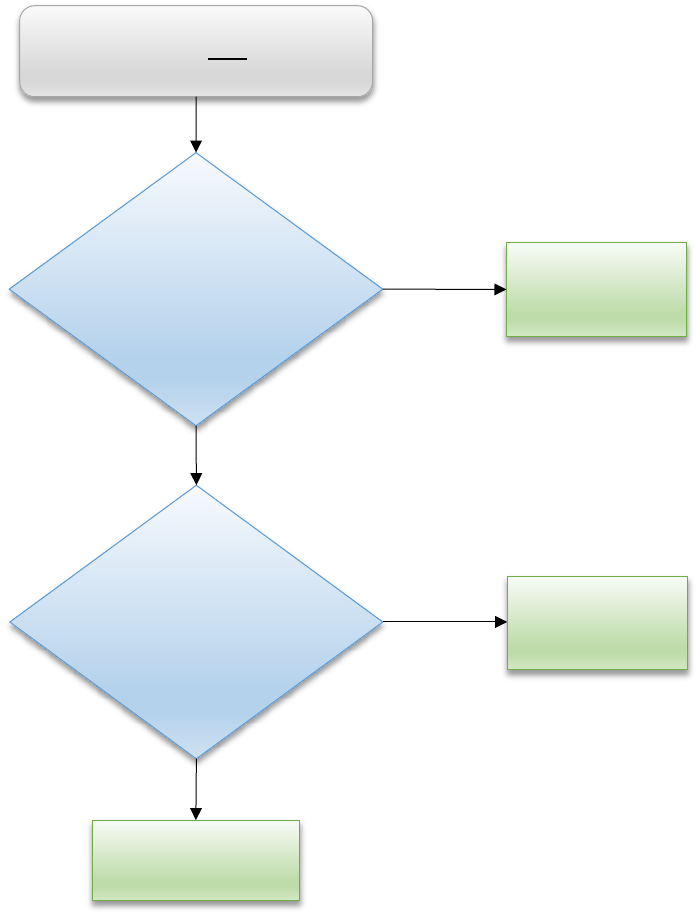
48
Paragraph (7): Items Transferred between Divisions of a Contractor
The following decision tree recommends a thought process in making a CID under paragraph (7) of the FAR
2.101 commercial item definition for “items transferred between divisions of a contractor.”
.
Prime contractor determinations of commerciality for interdivisional transfers bring a series of complexities that
require an independent review of the prime’s CID.
NO
NO
YES
YES
Does the proposed
item, combination of
items, or services meet
any of the criteria of
paragraphs (1) through
(6)?
Commercial under
Paragraph (7)
Not Commercial
under
Paragraph (7)
Paragraph (7) definition:
Define product AND identify
product’s functionality and purpose
Are the items or
services transferred
between divisions
internal to the
contractor?
Commercial
under a different
paragraph

49
Interdivisional sales should not be solely relied upon to establish commerciality. Nor does a commercial item
lose its commercial item status just because it is transferred between the contractor’s divisions/segments. In
other words, a commercial item transferred from a commercial division to a defense division within the same
company is still a commercial item. Although contractors are required to substantiate that transferred items
meet the commercial item definition, contracting officers are ultimately responsible for determining the
commerciality of an item transferred between divisions of a company. A division may have performed some
market analysis to support a make-or-buy decision for a particular item. These types of analysis may aid a
contracting officer in making a commercial item determination.
NOTE: If necessary, contracting officers should seek assistance from DCMA when evaluating the
commerciality of items transferred between divisions of a company.
Application
Ultimate Aerospace Corporation is one of a handful of companies that dominate the global
commercial aviation marketplace, and it also produces many aircraft solely for military use.
The Army has a FAR Part 15 aircraft program that shares many functions and performance
characteristics uses with long range commercial aircraft. Ultimate Aerospace Corporation
has proposed to utilize its own commercial engines transferred directly from another
production line. DCMA has verified that the same engine was produced on the contractor’s
commercial production lines and transferred without change for use on the production line
for the Army’s aircraft. The contracting officer agreed that the engine met the criteria for a
commercial item under paragraph (7) of the FAR definition of commercial item.
Key Concept
The contracting officer may presume that a commercial item transferred from a commercial production
line to a military program may be commercial provided that the commerciality is verified in accordance
with the commercial item definitions.
Part B will discuss pricing analysis using comparable commercial engines and how to research other market
analyses to support price analysis.
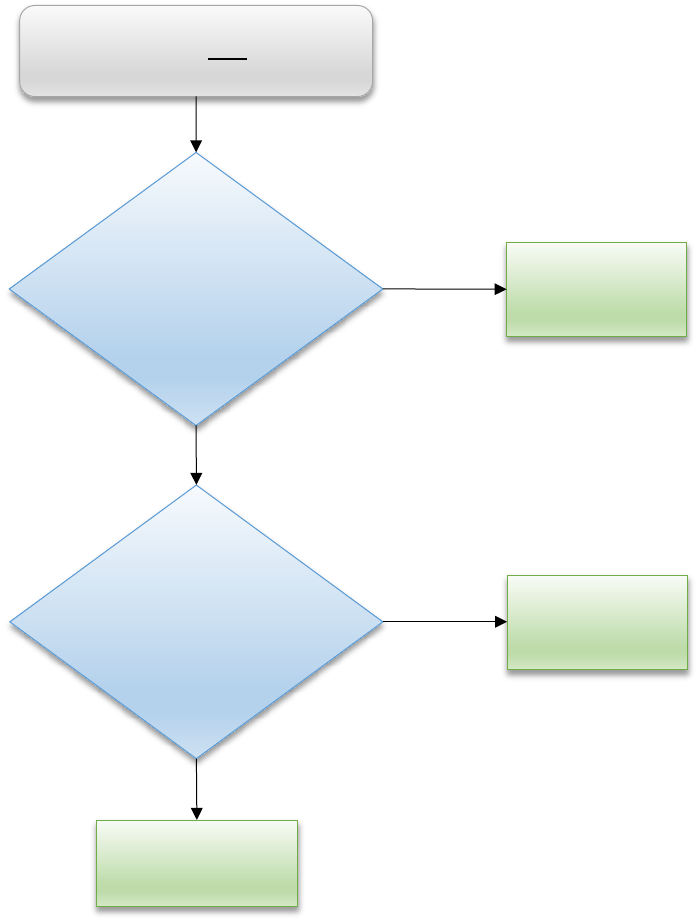
50
Paragraph (8): Non developmental Item (Product)
The following decision tree recommends a thought process in making a CID under paragraph (8) of the FAR
2.101 commercial item definition for “NDIs”
Paragraph (8) establishes the criteria for determining whether an NDI is commercial. Non-developmental
products are essentially products that were previously developed exclusively at private expense for use by State
and local governments (or are paragraph (3) modified commercial products). To qualify, an NDI must meet
three basic requirements:
• The product was developed entirely at private expense;
• The product was sold in substantial quantities; and
NO
NO
YES
YES
Was the product
developed exclusively
at the private
company’s expense?
Commercial under
paragraph (8)
Not commercial
under
paragraph (8)
Paragraph (8) definition:
Define product AND identify
product’s functionality and purpose
Did the private
company sell
substantial quantities
on a
competitive basis
to multiple State and
local governments?
Not commercial
under
paragraph (8)

51
• The product was sold on a competitive basis to State and local governments. (Note: FMS and sales to
the Federal Government do not count.)
NOTE: FAR 31.205-18 allows companies to engage in R&D efforts independent of a particular
contract or customer, with the Government agreeing to reimburse reasonable, allowable, and allocable
independent R&D (IR&D) costs. The resulting technology is considered “developed exclusive at
private expense” as an inducement for contractors to engage in IR&D and because the R&D was executed
independent of any particular contract. The Government, however, would reimburse the contractors for IR&D
as indirect expenses. This method allows the contractor to retain all licensing rights. Examples of such
products can include fire and rescue equipment, specialized equipment used by law enforcement, and other
products used by State and local governments, but not sold to the general public.
Application
Amazing Concepts, Inc. has produced a variety of commercial products using cutting edge
technology, and it is a leader in the use of small drones for innovative commercial use.
Amazing Concepts developed, at entirely its own expense, a small, flexible drone that contains
a camera capable of scanning and transmitting real-time, highly accurate video at high altitude.
Amazing Concepts marketers notified the Navy that they could provide this commercial
product quickly to meet an emerging need. The Navy was impressed by the performance trials
and video, but the contracting officer noticed that the price quote seemed unusually expensive.
The contracting officer asked for prior sales data and found that of the three instances of prior
sales, two were to foreign governments, and the third was a sole source FMS sale directed by
the customer.
The contracting officer concluded that: (1) it did not meet the definition of an NDI because it
had been sold only to foreign governments and to FMS, rather than to State or local
governments; and (2) insufficient sales were available to conduct a meaningful price analysis.
Key Concepts
Military-unique items and commercial item components: FAR 52.244-6(b) specifically requires “to the
maximum extent practicable, the contractor shall incorporate, and require its subcontractors at all tiers to
incorporate, commercial items or non-developmental items as components of items to be supplied.”
Therefore, do not presume a component of a military-unique item is not commercial.
Impact of Research & Development (R&D) funding on commercial item: The fact that the development
of an item may have been funded - in whole or in part - either directly (i.e., R&D contract) or indirectly
(i.e., IR&D) does not prohibit the item from being recommended as commercial, especially if the item is
being sold in the commercial market place to non-Government customers.

52
Other Considerations
PRIME CONTRACTOR ASSERTIONS OF SUBCONTRACTOR COMMERCIALITY
Major weapons systems are complex products that will contain many commercial items the supply chain. As
previously mentioned, the prime contractor has the responsibility to determine whether a particular subcontract
item meets the definition of commercial item. It should be a common practice that prime contractors compete
suppliers of components on a regular basis. Upon request by a contracting officer, prime contractors are
required to provide a copy of their determinations of commerciality.
USE OF COMMERCIAL ITEM PROCEDURES FOR NONTRADITIONAL DEFENSE
CONTRACTORS
Per 10 U.S.C. 2380(A), supplies and services provided by nontraditional defense contractors may be treated as
commercial items. This permissive authority is intended to enhance defense innovation and create incentives
for cutting-edge firms to do business with DoD. It is not intended to re-categorize current noncommercial
items.
NOTE: The decision to apply commercial item procedures to the procurement of supplies and
services from nontraditional defense contractors does not constitute a requirement for a commercial
item determination and does not mean the item is commercial. The contracting officer must document
the decision to apply commercial item procedures in the procurement file prior to the procurement from a
nontraditional defense contractor.
MAJOR WEAPONS SYSTEM, SUBCOMPONENTS, AND SPARE PARTS
In accordance with 10 U. S.C. 2379, departments and agencies shall obtain a CID executed by the Secretary of
Defense, which includes a determination that treatment of the major weapons system as a commercial item is
necessary to meet national security objectives. This authority may not be delegated below the level of the
Deputy Secretary of Defense. In addition, the statute requires notification of the congressional defense
committees at least 30 days prior to such acquisition occurs. The DoD policy for acquiring major weapon
systems as commercial items is implemented at DFARS Subpart 234.70.
COTS ITEMS
COTS products seem like an easy subject, and some have questioned why COTS products should be addressed
in this Guide. After all, we believe that we intuitively understand what COTS products are because we procure
such products for ourselves every time we shop. However, COTS does have its own challenges and can be
complex in an acquisition.
Questions to Consider

53
Consider the following questions regarding COTS items:
• What constitutes “substantial quantities”? How much is enough?
• What does “without modification” mean when some products are routinely
customized in the marketplace?
• If it is sold somewhere in the same form in the commercial marketplace, is it then
COTS?
• If I have a commercial item determination, do I need another determination that the
item is COTS?
• When is an item no longer COTS?
Obsolescence as it Relates to COTS
Although the use of COTS products is frequently less expensive and easier to maintain, one must also keep up
with the marketplace or risk obsolescence, and the lack of availability of parts due to new designs or other
changes. When the manufacturers introduce new versions or delete older models, so must the procuring
organization or risk having an item that is no longer supportable. Program managers must plan for timely
replacement in concert with the market place and include clauses in the contract to procure spare parts as COTS
items for the length of the contract.
Questions to Consider
How can you determine when a part is about to become obsolete? It is essential for the
contracting officer to work with the program manager and supply chain management to
address parts that could be in danger of losing their COTS status. Some symptoms are:
• Notification that a part that will be discontinued in the future;
• It can be produced by only one manufacturer;
• Dwindling inventory of parts for a system; and
• A parts list that contains an end-of-life cycle part before a system has gone into
production.
Application

54
One example of such obsolescence is the Condor Cluster, an Air Force supercomputer built
out of 1,760 video game consoles running the free, open access, Linux operating system. It
was an elegant and inexpensive solution until the manufacturer upgraded to a newer version
and no longer supported the particular version of the video game console. The Air Force
had no means to procure replacement units. Although this is an extreme example, the
Department tends to retain equipment longer than the commercial marketplace, making such
obsolescence relatively common. This in time will require either replacement or very
expensive customized maintenance. Occasionally, the Government will contract with the
manufacturer to stabilize some COTS products for extended Government use and include
some features as a joint effort.
Significance to DoD Procurement
Certain key laws affecting DoD procurement make a distinction between a commercial item and COTS items
and are important to be aware of when conducting commercial item procurements.
• The Buy American Act, 41 U.S.C. 8301–8305, differentiates between commercial items and COTS
items. The Buy American Act grants an exception for component test of the two-part test for COTS
products, thereby allowing the contracting officer to increase competition by considering for
procurement COTS products manufactured in other countries.
• 10 U.S.C. 2533(b), “Restrictions on DoD Procurement of Specialty Metals,” also makes a distinction
between commercial items and COTS items. The law contains a COTS exception that enables the
contracting officer to procure many U. S. manufactured parts that contain specialty metals that were not
melted or produced in the United States or a Qualifying Country. Manufacturing and steel production is
global, and manufacturers prefer to change their suppliers frequently. The contracting officer should
ensure that he or she includes DFARS clause 252.225-7009, Restriction on Acquisition of Certain
Articles Containing Specialty Metals, for procurement of manufactured items for use in the major DoD
weapons systems listed as: aircraft; missile or space systems; ships; tank or automotive items; weapon
systems; and ammunition. Virtually all weapons systems contain components that contain specialty
metals that harden it to extreme temperature ranges and other stresses. The contracting officer would be
wise to require proof that the manufactured parts are DFARS compliant and, if applicable, include the
contractor’s certification in the procurement file that all relevant parts are COTS items.
Practical Example No. 7
COTS items
Objective: DLA wishes to maintain sources of supply for a wide variety of COTS components
for military aircraft that have commercial equivalents. The COTS status of
components is important to document and maintain because it helps to increase
competition for third party vendors, in addition to the original equipment
manufacturer (OEM), to provide parts and services to support these COTS parts.

55
Background: It is customary in the commercial aviation industry to customize aircraft to meet the
customer’s preferences, similar to the optional packages offered for commercial cars.
The military services have acquired several aircraft, such as the C-17, the C-130J, the
P-8, the KC-46, and trainers that have commercial equivalents. Although these
aircraft might not be determined to be commercial themselves, they contain a
significant amount of commercial components. Although the developmental contracts
cover initial spares, obsolescence may occur decades later.
Analysis: In the case of spare parts, one must consider and document COTS status, as well as
commerciality if the COTS status is critical to Government procurement of the part.
When DLA procured replacement engines for an aircraft, it procured COTS engines
that were widely sold in substantial quantities in the commercial marketplace and
used in many commercial aircraft types. When an inspector questioned if all of the
parts in the COTS engine were still COTS, or if a small number of military variant
parts were now obsolete, the contracting officer replied that the engine was clearly
COTS and met the criteria of the FAR definition. DLA maintained that the engine
may have some customizing preferences, but that did not preclude the COTS
designation of the engine any more than a truck with a ruggedized cargo bed
precluded it from receiving a COTS designation. Although obsolescence for an
individual part might be an issue in some cases, those same parts were still COTS
when embedded in the COTS engine.
Results: All parts of the widely sold COTS engine were judged to be COTS parts, and DLA
saw the value of documenting COTS determinations in such circumstances.
Takeaways:
Components of a COTS assembly may be presumed to be COTS for the
economic life of the assembly, but the corollary is not necessarily true; COTS
parts usually, but not always, indicate that the more complex assembly or system
also will be COTS.
Upon receipt of the prime contractor’s proposal, the analyst should review the
documentation of all parts, not simply for commercial item determination, but
also for COTS status if COTS status is a concern. Some laws differentiate
between COTS and commercial items. Be careful that you examine the
contractor’s certification regarding compliance with the Buy American Act and
Restrictions on DoD Procurement of Specialty Metals when procuring COTS
items.
DFARS clause 252.225-7009 is required by law to be included in all applicable
contracts and flow down from the primes to the lowest tier of the supply chain.
When obtaining information from the offeror, it may be best to submit an official
RFI to obtain the required documentation.
Summary Highlights
CID is the first part of a two-step process for evaluating commercial items, and it is the foundation for effective
commercial item pricing. By applying the concepts in this guide and other resources as available, a CID can be
completed efficiently in approximately ten business days. The Guide serves as a tool in promoting competition
by conducting effective market research and improving CID decision making and documentation. The
examples included herein illustrating the policy and concepts should help you understand the breakdown of the
commercial item definition and how it should be applied to your commercial item analysis. Part B of this Guide
addresses strategies and techniques to establish a fair and reasonable price for commercial items and services.

56
Appendix A: Initial Market Research Resources
The sources of market research listed below are focused on initial market research. See Appendix A for a
listing of market research sources to determine price reasonableness.
General Research Sites Search Engines
Global Spec – http://www.globalspec.com
(Wide range of commercial products and services, vendor catalogs and product
specification)
Supply View – http://www.supplyview.com
(Electronic components, electromechanical parts, commercial and military aviation
parts, and more. Queries can be accomplished by part number, NSN number, and
description)
Super pages – http://www.superpages.com
(Commercial products and services for any geographical area or the entire nation)
GovCon – http://www.govcon.com
(Commercial products and services, and vendor catalogs)
MarketResearch.com – http://www.marketresearch.com
(Market trends, product research, industry-specific reports, market intelligence)
* Requires Paid Account
Federal Government Research Sites
Federal Business Opportunities (FedBizOpps) – https://www.fbo.gov
(The largest data base for current Federal business opportunities, can be used to find
other Federal institutions buying similar items. Enables search by NSN or key words.)
Federal Procurement Data System-Next Generation –
https://www.fpds.gov/fpdsng_cms/index.php/en/
(Includes all Federal contracts with an estimated value of $3,000 or more. Every
modification to that contract, regardless of dollar value must be reported to FPDS-NG.)
AbilityOne Program – http://www.abilityone.gov
(Products and services provided by people who are blind or have significant
disabilities)
North American Industry Classification System (NAICS) -
https://www.census.gov/eos/www/naics
The North American Industry Classification System or NAICS is used by business and
Government to classify business establishments according to type of economic activity
process of production.)
International Trade Administration - http://trade.gov
(Research tool that contains data and analysis on specific industries)
Department of Commerce - http://commerce.gov

57
(Research tool that contains data and analysis on specific industries and economic
indicators)
Acquisition.Gov – https://www.acquisition.gov/
(Website that contains helpful resources)
U. S. Securities and Exchange Commission EDGAR Database Company Filings -
https://www.sec.gov/edgar/searchedgar/companysearch.html
(Database of annual and quarterly SEC financial reports filed by publicly traded
companies, can be used for research into a company’s business practices and current
sales projections)
Department of Defense Resources
Contract Business Analysis Repository (CBAR) – http://www.dcma.mil
Defense Standardization Program (DSP) – http://www.dsp.dla.mil/Programs/Parts-
Management
(Database of standardized DOD parts that can be used on systems to leverage large
quantity buys and reduce costs)
DCMA Commercial Item Group (CIG) – http://www.dcma.mil/commercial-item-
group/
(Online resource for commercial products and services, DoD Commercial Item
Database, and additional commercial item resources)
Industry Associations References
American National Standards Institute (ANSI) – http://www.ansi.org
(Trade associations, Industry and Government professionals seeking common
standards)
National Defense Industrial Association – http://www.ndia.org
(Manufacturers of defense products and service providers for the U.S. and allies)
Telecommunications Industry Association (TIA) – http://www.tiaonline.org/
(Communications and Information Technology industry)
Government-Industry Data Exchange Program (GIDEP) – http://www.gidep.org
(Data bases for supplies/services of interest to Government and industry)
Society of Manufacturing Engineers – http://www.sme.org
(Latest information on technology trends and new developments)
Society for Technical Communication – http://www.stc.org
(Promotes standardized technical communication across all industries)
International Society for Logistics – http://www.sole.org
(Logistics support providers in industry and Government)
Additional Resources:

58
Link to DAU Market Research CLC 004 Market Research
http://icatalog.dau.mil/onlinecatalog/courses.aspx
This module provides a foundational understanding of the benefits of effective market
research to reduce acquisition costs and cycle times, and provide greater access to
advanced technologies.
Link to DAU “Ask a Professor” https://dap.dau.mil/aap/pages/
Ask A Professor (AAP) is a Department of Defense resource for asking acquisition and
logistics questions concerning policies and practices.
Link to Services Acquisition Mall http://www.sam.dau.mil
DAU’s Service Acquisition Mall provides usable tools and templates to create
performance-based service acquisition requirements. The Mall consists of “Wings” and
"Stores" that contain information related to categories of service.
Link to Automated Requirements Roadmap Tool (ARRT)
https://www.dau.mil/tools/Acquisition-Requirements-Roadmap-Tool-(ARRT)-Suite
ARRT is designed to help improve the tradecraft in service acquisitions and develop
performance based service requirements following a proven process.
Market research report template is posted on the DPAP Website at
http://www.acq.osd.mil/dpap/cpic/cp/marketresearch.html

59
Appendix B: Template for New Commercial Items
The CID Template provided below is recommended for the use of the contracting officer in preparing future
CIDs. The template indicates the essential information to include in any CID and provides a standardized
format.
Date - Month Day, Year>
MEMORANDUM FOR RECORD
SUBJECT: Commercial Item Determination: <Prime Contractor name / Subcontractor name and proposal
identifier (e.g., proposal number, RFP number, contract number>
TABLE OF CONTENTS
DESCRIPTION OF ITEM OR SERVICE PROPOSED .................................................................1
REFERENCES ................................................................................................................................1
EXECUTIVE SUMMARY OF COMMERCIAL ITEM DETERMINATION (CID) ....................2
GOVERNMENT PERSONNEL INVOLVED IN THE ANALYSIS .............................................2
STATEMENT OF ADEQUACY OF CONTRACTOR’S SUBMISSION .....................................2
SUMMARY OF GOVERNMENT TECHNICAL EVALUATION ...............................................2
MARKET RESEARCH ...................................................................................................................2
COMMERCIALITY ASSESSMENT .............................................................................................3
RESTRICTIONS .............................................................................................................................3
ADDITIONAL INFORMATION ....................................................................................................4
REVIEWS AND APPROVALS ......................................................................................................5
ATTACHMENTS ............................................................................................................................5
DESCRIPTION OF ITEM OR SERVICE PROPOSED
The format can be a brief narrative, table, bullet statements, or any combination of formats but must contain the
following:
• Description of the acquisition (i.e., what commercial items or services are proposed)
REFERENCES
A list of documents or other sources referenced in but not attached to the report >
EXECUTIVE SUMMARY OF COMMERCIAL ITEM DETERMINATION (CID)

60
This is a summary and includes only a high-level overview of the Contracting Officer’s CID. Detailed support
for the findings is presented in the appropriate report sections. The format can be a brief narrative, table, bullet
statements, or any combination of formats.>
The following information is included in the summary>
Commerciality Review:
• Description of the items proposed as commercial (with part number(s), and/or descriptions, description
of services proposed)
• Contractor’s CID findings (if applicable)
• Contracting Officer’s determination, including the subparagraph of the FAR commercial definition that
applies to this particular item
Note: the COMMERCIALITY ASSESSMENT section of this report addresses the above determination in
greater detail.
GOVERNMENT PERSONNEL INVOLVED IN THE ANALYSIS
NAME/TITLE
AGENCY/OFFICE
TELEPHONE
NO.
E-MAIL
ADDRESS
<Contract
Specialist/Price/Cost
Analyst Name/Title>
STATEMENT OF ADEQUACY OF CONTRACTOR’S SUBMISSION
A narrative statement about performing a review of the applicable part of the contractor’s proposal, as
applicable, with a focus on the contractor’s Commercial Item Determination (CID), if applicable.>
SUMMARY OF GOVERNMENT TECHNICAL EVALUATION
If applicable, a narrative summary of the Technical Evaluation highlighting pertinent information relied upon to
support the Contracting Officer’s CID.>
MARKET RESEARCH
Provide a brief summary of the market research performed to include at least one paragraph for strategic market
research (industry overview with number of commercial competitors) performed and at least one paragraph for
tactical market research (similar commercial item comparison table) performed, and the results of the market
research; ensure Market Research data is included in the CID.>
COMMERCIALITY ASSESSMENT
Include a narrative summary of the contractor’s CID (if applicable), including the contractor’s basis.>
Include a clear statement of determination along with the details supporting the determination. Identify the
specific FAR 2.101 commercial item subparagraph (i.e., paragraph (1), (3)(i), etc.) definition for the CID.

61
Among others factors, the contracting officer should include a description of the essential physical
characteristics of the contractor’s proposed of a type product or service, and how does it compare to a
comparable commercial product or service? Recommend showing a side-by-side comparison of the
contractor’s proposed product or service and the commercial comparable product or service using a comparison
table.
The format can be a narrative, table, bullet statements, or any combination of formats. The following is an
example of the table format.
Prime
Contractor P/N
Subcontractor
P/N
Description
Prime
Contractor’s CID
Contracting
Officer’s CID
(i.e., Paragraph 1,
Paragraph 3(i))
(i.e., Paragraph 1,
Paragraph 3(i))
RESTRICTIONS
1. The contents of this report should not be released or disclosed other than to those persons whose official
duties require access in accordance with DoD 5200.1-R, Information Security, January 1997 (as amended),
Appendix 3, paragraph AP3.2.3. This document may contain information exempt from mandatory disclosure
under the Freedom of Information Act. Exemption 4, of the Freedom of Information Act, which addresses
proprietary information, may apply. The CID should be marked “FOR OFFICIAL USE ONLY”
2. Proprietary data determinations should be made in the event of an external request for access.
Unauthorized disclosure of proprietary information violates 18 U.S.C. 1905 (Disclosure of confidential
information generally) and, if the information is contractor bid or proposal or source selection information, 41
U.S.C. 423 (Restrictions on disclosing and obtaining contractor bid or proposal information or source selection
information). Any person who unlawfully discloses such information is subject to penalties such as fines,
imprisonment, and/or removal from office or employment.
NOTE: Restrictions 1 and 2 above are required unless determined not applicable. Restriction 3 below is
required for subcontractor proposal analysis to support the prime contractor or higher-tier subcontractor. If the
analysis is subcontractor field pricing assistance to a prime contractor, the analyst (or other responsible
Government personnel) shall obtain written restrictions from the subcontractor regarding release of the data
provided to the Government for analysis. The analyst shall prepare an unsanitized report and a second separate
sanitized report that complies with the subcontractor’s written restrictions for release to the prime contractor. A
contracting officer (PCO or ACO) must review the second report to ensure compliance with the subcontractor’s
written restrictions before releasing to the prime contractor.
Include the following Restriction 3 in the unsanitized report provided to the PCO/ACO.
3. This restriction addresses the release of subcontractor information or data to the prime contractor (or a
higher-tier subcontractor) as prescribed in DFARS PGI 215.404-3(a). This report does not comply with the
written restrictions on the release of subcontractor information or data provided by <Subcontractor Name>
contained in Tab <Letter>. Tab <Letter> contains a second report complying with these written restrictions.
Prior to releasing the second report, the responsible contracting officer must ensure it complies with the written
restrictions provided by the subcontractor.

62
Include the following Restriction 3 in the sanitized report to be released to the prime contractor (or a higher-tier
subcontractor).
3. This memorandum is releasable to the prime contractor in accordance with the subcontractor’s written
restrictions on the release of subcontractor information or data provided by <Subcontractor Name> contained in
Tab <Letter>. Prior to releasing this memorandum to the prime contractor, the responsible contracting officer
must ensure it complies with the written restrictions provided by the subcontractor.>
ADDITIONAL INFORMATION
If you would like assistance with your CID or price reasonableness for commercial items the DCMA
Commercial Item Group (CIG) can provide assistance with commercial item determinations and price
reasonableness. Submit your request to the DCMA CIG email address commerc[email protected].> Be advised
that if a contracting officer requests assistance from the DCMA CIG with a commercial item determination,
then the contracting officer will be required to follow the DCMA CIG’s conclusion.
REVIEWS AND APPROVALS
_______________________________________________ ______________
Name of Preparer DATE
Title of Preparer (e.g., Contract Specialist, Engineer, etc.)
_______________________________________________ ______________
Name of Reviewer DATE
Title of Reviewer (e.g., Contracting Officer)
ATTACHMENTS
Tab A – Document Name and Date (if applicable)
Tab B – Document Name and Date (if applicable)
Tab C – Document Name and Date (if applicable)>
Letter tabs as illustrated above. If there are no attachments to the report enter “None” after the
ATTACHMENT section name (i.e., ATTACHMENTS: None).
archived for the DoD’s future access and use.
